Special Report
The Stories Behind the Nation’s Oldest Newspapers

Published:
Last Updated:

What is a newspaper — other than an endangered species in this digital age? Merriam-Webster defines it as “a paper that is printed and distributed usually daily or weekly and that contains news, articles of opinions, features, and advertising.”
According to the World Association of Newspapers and News Publishers, the first newspaper in existence was the German-language Relation aller Fürnemmen und gedenckwürdigen Historien (Account of All Distinguished and Commemorable News), published in a book-like format in 1605 in Strasbourg — now in France, but then part of the Holy Roman Empire. The first publication in broadsheet format, more or less like a modern paper, was Courante uyt Italien, Duytslandt, &c. (Current Events from Italy, Germany, etc.), published in Amsterdam in 1618.
The first American newspaper, Publick Occurrences, Both Foreign and Domestick, was published in Boston in 1690, but it didn’t last long: After only one issue, it was suppressed by the colonial authorities because it contained, as the governor of Massachusetts put it, “sundry doubtful and uncertain Reports” (fake news?) — and because it had been published without the required license.
Click here for the stories behind America’s oldest newspapers.
Click here to read our detailed findings and methodology.
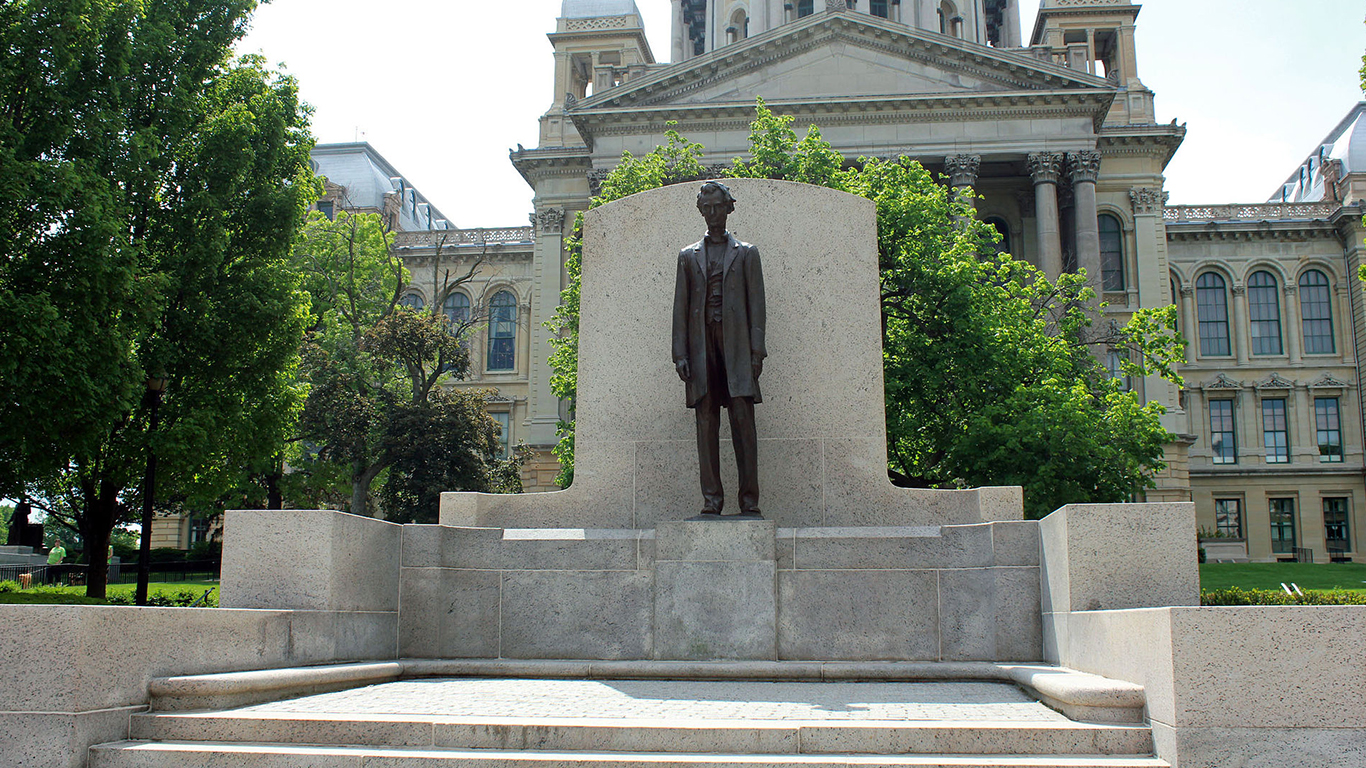
30. The State Journal-Register
> Year founded: 1831
> Place founded: Springfield, IL
> Original name: Sangamo Journal
Like all the newspapers on this list, the State Journal-Register has a complicated parentage. It began with Springfield editor Simeon Francis, a great friend and longtime supporter of Abraham Lincoln, who founded the pro-Whig Sangamo Journal in 1831 (the county is Sangamon, but the paper spelled it without the “n”). Though Lincoln was to become the first Republican president, he served four terms as an Illinois legislator and one as a U.S. congressman as a member of the Whig Party, and he wrote frequently for the Journal — usually under a pseudonym — and supported it in the community. In 1855, however, when Lincoln, already an influential politician, declined to help Francis stave off a new competitor, Francis sold the Journal and left town.
In 1836, a Delaware-born printer and journalist named William Walters had started a Democratic-leaning newspaper, the Illinois State Register and Vandalia Republican, in Vandalia (then the state capital), about 60 miles southeast of Springfield. When the capital was moved to Springfield in 1839, the Register followed. Walters ran the paper until 1846, when he was enlisted to fight in the Mexican-American War but died en route to the hostilities.
The Journal and the Register both changed hands several times in the ensuing decades, and in 1928, the Journal was bought by Illinois native Ira Clifton Copley as part of his growing chain of small-town newspapers. In 1942, the Register was added to Copley’s portfolio. The papers merged into the State Journal-Register in 1974, and since 2007, the publication has been owned by GateHouse Media, which publishes 145 daily newspapers and 340 community publications in 37 states.
[in-text-ad]
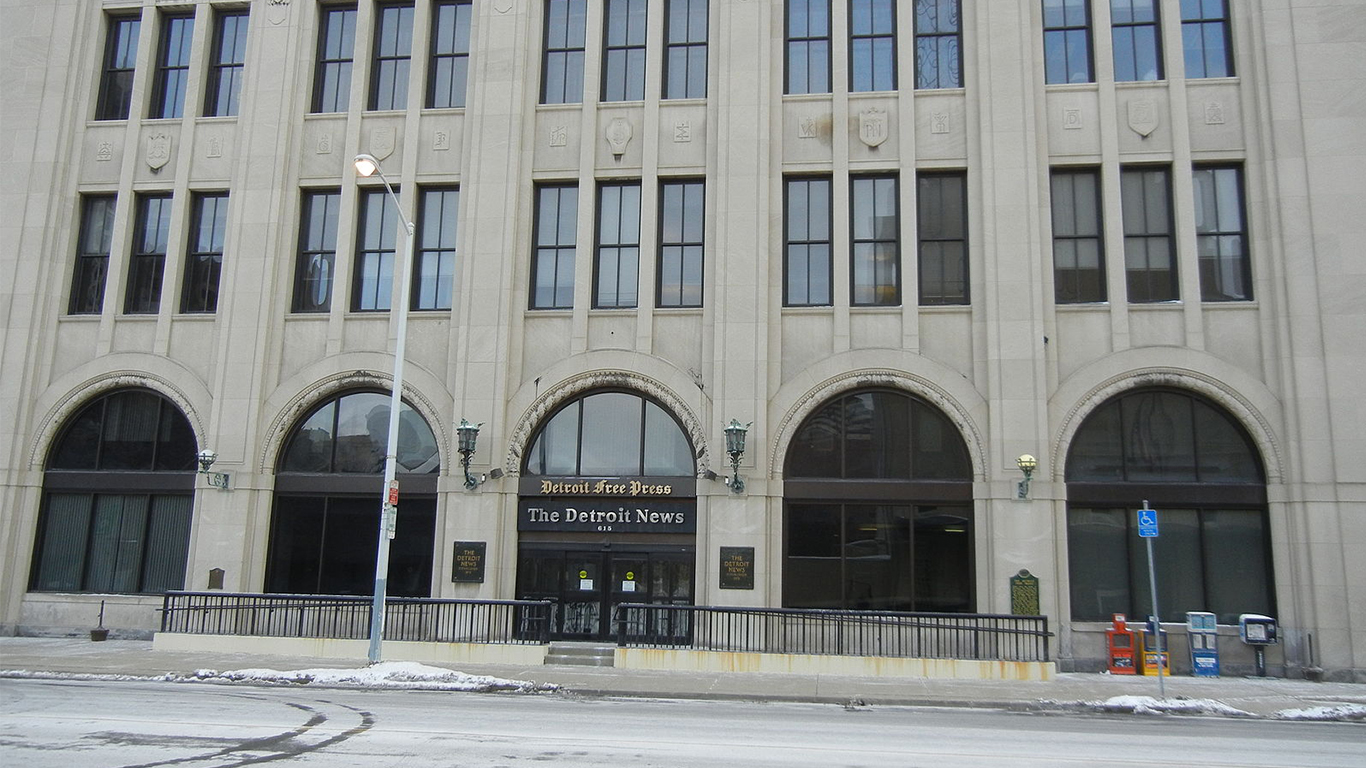
29. Detroit Free Press
> Year founded: 1831
> Place founded: Detroit, MI
> Original name: The Democratic Free Press and Michigan Intelligencer
In 1831, a 21-year-old fledgling publisher named Sheldon McKnight, with backing from his family and from Detroit’s first mayor, John R. Williams, published the first issue of a four-page weekly he dubbed the Democratic Free Press and Michigan Intelligencer. Four years later, the paper became a daily, and the name was changed to the Detroit Daily Free Press. The “Daily” was later dropped.
An anti-Civil War Vermonter, Wilbur F. Storey, moved to Detroit in 1853 and bought an interest in the paper, eventually becoming its editor and sole proprietor. He was an innovative publisher, introducing the first regular Sunday edition in the country, sending correspondents to cover the Civil War by telegraph, and publishing a London edition — the first American newspaper to appear in Europe.
The paper was bought by John Knight, founder of Knight Newspapers, in 1940. When Knight merged with another media company, Ridder Publications, to form Knight Ridder in 1974, the Free Press remained under the company’s ownership. The McClatchy Company, which in 2006 purchased Knight Ridder, is now the Free Press’s corporate parent.
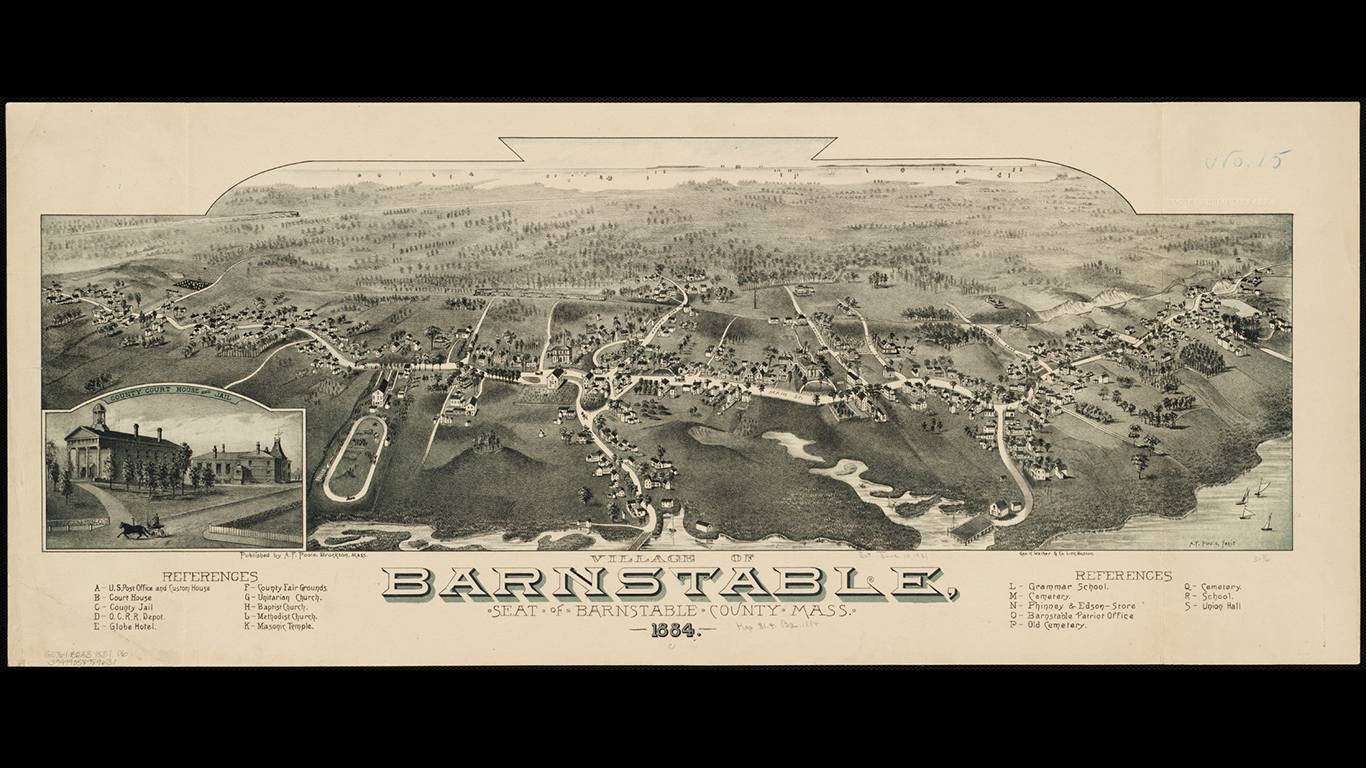
28. The Barnstable Patriot
> Year founded: 1830
> Place founded: Barnstable, MA
> Original name: The Barnstable Patriot
The Patriot was founded in the Cape Cod town of Barnstable by 22-year-old Sylvanus Bourne Phinney. Phiney was the scion of a distinguished local family (his father descended from a Mayflower Pilgrim; his mother from the last governor of the Plymouth Colony) who himself went on to serve as Collector of the Barnstable Customs House under four presidents. Phinney published his first issue on June 26, 1830, with the note to the readers that “Should sufficient encouragement be offered, the second number will be issued about the 10th of July.” It must have been, because the paper survives to this day.
When Phinney was ready to retire, he gave editorship of the paper over to his friend George Sewall Boutwell, who had been a governor of Massachusetts, a senator, a member of the House of Representatives, and the first Commissioner of Internal Revenue (the forebear of the Internal Revenue Service). The Patriot was sold again in 1869 and twice more in the early 20th century. When it celebrated its centennial in 1930, President Herbert Hoover sent a letter of congratulations. Today, after two more ownership changes, the weekly Patriot belongs to massive GateHouse Media, which publishes 145 daily newspapers and 340 community publications in 37 states.
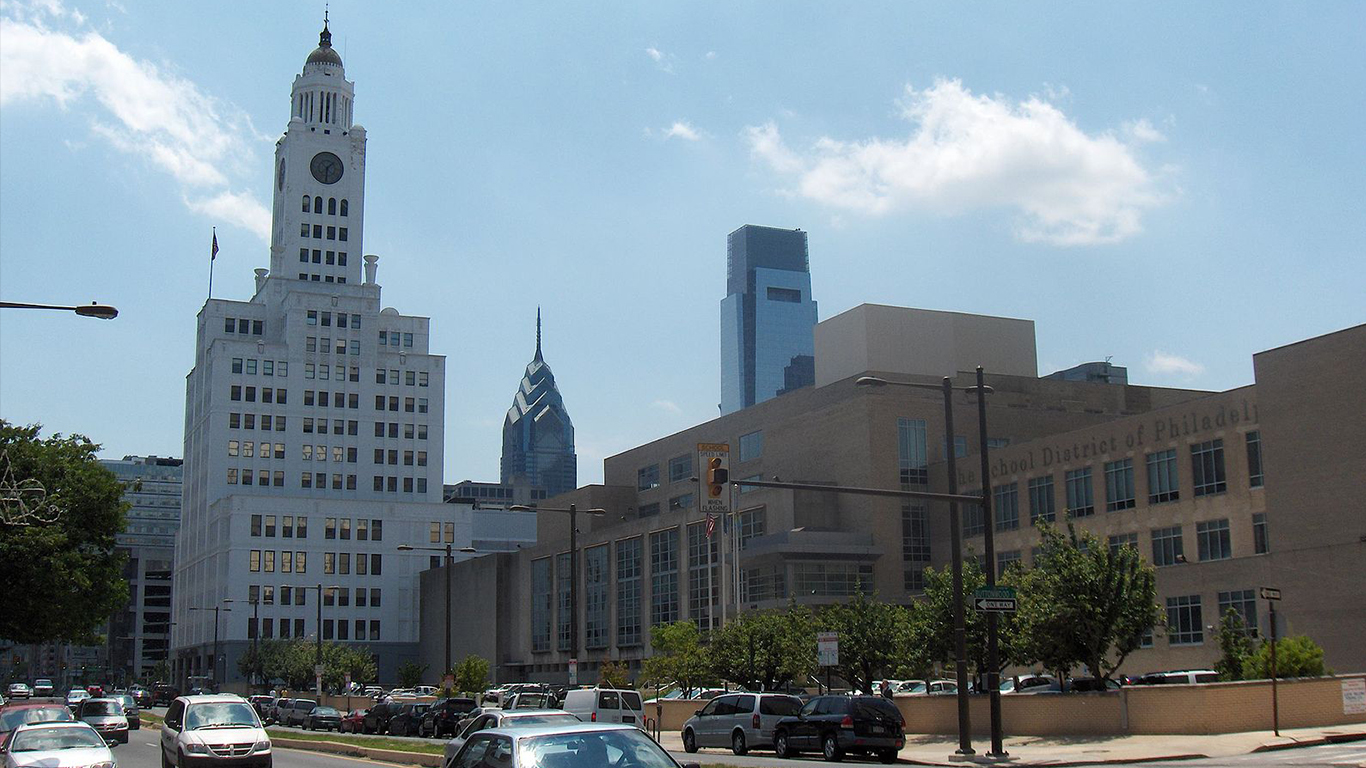
27. The Philadelphia Inquirer
> Year founded: 1829
> Place founded: Philadelphia, PA
> Original name: The Pennsylvania Inquirer
In 1829, Philadelphian John Norvell, who had edited the city’s Daily Aurora & Franklin gazette, launched a newspaper in the city called the Pennsylvania Inquirer, in partnership with a young printer named John R. Walker. A note in the first issue proclaimed that the Inquirer would be dedicated to the “maintenance of rights and liberties of the people, equally against the abuses as the usurpation of power.”
Unfortunately, the paper was not a success, and the founders sold it after only a few months to Jesper Harding. Harding, who subsequently became the largest publisher of Bibles in America, gave the paper over to his son, William, in 1859, and the following year William changed its name to the Philadelphia Inquirer.
The Inquirer came to national attention for its coverage of the Civil War, but following the end of that conflict, Harding sold it to English-born James Elverson, Sr., publisher of a magazine called Philadelphia Saturday Night. In 1936, it ended up in the hands of Moses Annenberg, who already owned the Miami Tribune and the Daily Racing Form. His son, Walter, took over in 1942, becoming a well-known Philadelphia philanthropist and cultural leader. (Today there are journalism and communication schools named for Annenberg at USC and the University of Pennsylvania.)
Knight Newspapers, Inc. (later Knight Ridder Inc.) bought the Inquirer in 1969. Today, after several other owners, the paper has the unique distinction of being run by a public benefit corporation belonging to a nonprofit journalism institute that is in turn controlled by the Philadelphia Foundation, whose stated mission is “to improve the quality of life in the greater Philadelphia region.”
[in-text-ad-2]

26. The Post-Standard
> Year founded: 1829
> Place founded: Syracuse, NY
> Original name: The Onondaga Standard
The first issue of the weekly Onondaga Standard was published in Syracuse — the county seat of New York’s Onondaga County — in 1829. Out of this paper grew the daily Syracuse Standard, first published in 1883. In 1894, Frank W. Palmer, a Chicago newspaper editor who had also served as that city’s postmaster, as the Public Printer of the United States, and as a congressman from Iowa, launched a rival newspaper called the Syracuse Post. The Post and the Standard competed for readership — both were morning papers — and in 1899, the two agreed to merge.
In 1906, the Post-Standard hired a Syracuse high school student named Jerome D. Barnum to cover school news. He left to go to college for a year, then returned and took a job in the paper’s business department, working his way up until he was named publisher of the Post-Standard and treasurer of the corporation that owned it in 1916. He held the posts until 1942, when the paper was sold to S.I. Newhouse, later celebrated as the head of the Condé Nast magazine empire.
In 2012, the Newhouse family’s Advance Publications Inc. combined the Post-Standard with the Syracuse.com website to form the Syracuse Media Group. The group announced that the physical newspaper would now be published for home delivery only three days a week, with smaller editions available for single-copy sales the other four.
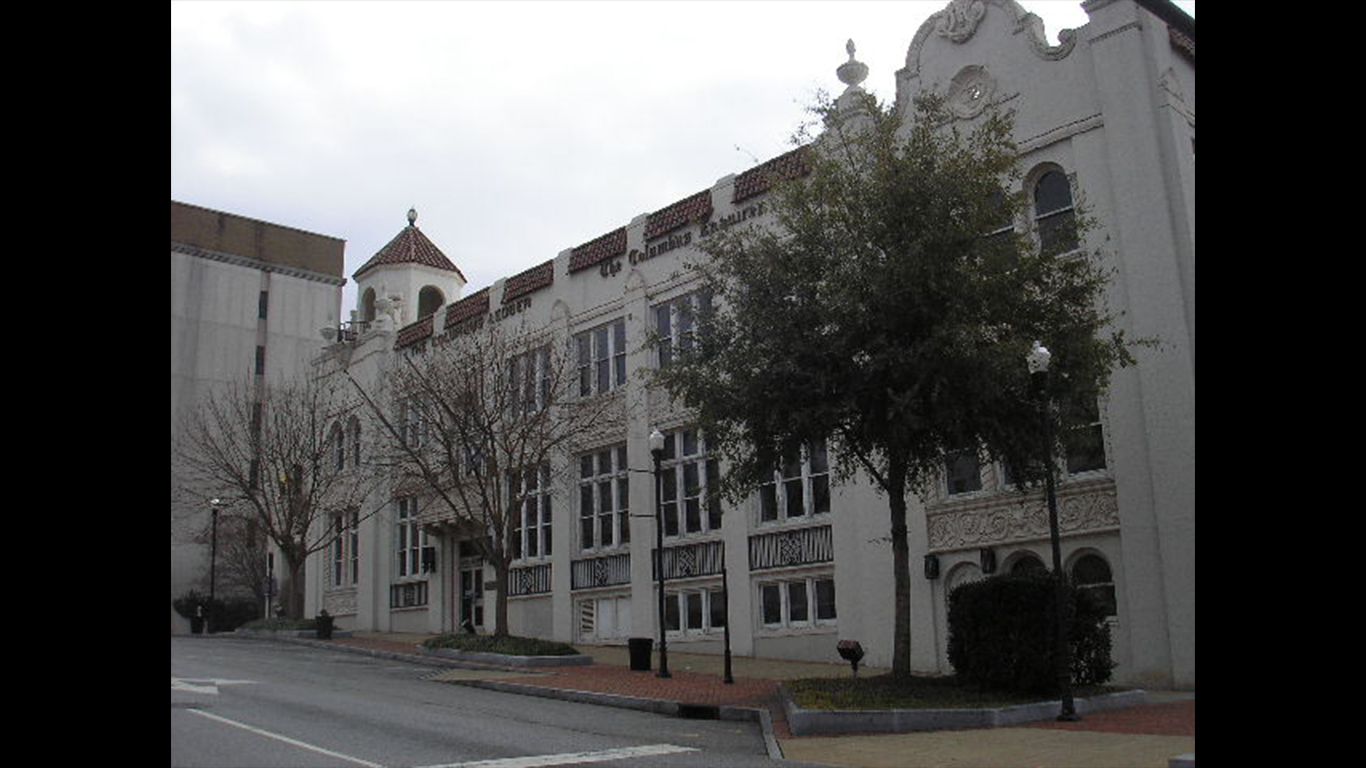
25. Ledger-Enquirer
> Year founded: 1828
> Place founded: Columbus, GA
> Original name: Columbus Enquirer
In 1838, Mirabeau Buonaparte Lamar was elected as the second president of the Republic of Texas. Ten years earlier, however, the Georgia-born Lamar had established a weekly newspaper (later a daily) called the Columbus Enquirer, in the town of Columbus, southwest of Atlanta.
The Enquirer’s future partner, the Columbus Ledger, was founded in 1886 by Georgia editor and publisher Edward T. Byington. An Alabama native, Rinaldo William Page, went to work at the Ledger the year it was launched as an advertising salesman, and in 1892, he and his brother-in-law, Larkin T. Jones, purchased the paper.
The Enquirer went on to win a Pulitzer Prize for Public Service in 1926 for its coverage of the so-called Scopes Monkey Trial (in which science teacher John Scopes was prosecuted for teaching evolution in a Tennessee school), its opposition to the Ku Klux Klan, and its stand against lynching. (It won a second time in 1955 for its investigation into corruption in Phenix City, Alabama.)
The Page family bought the Enquirer in 1930 and continued to run both publications until 1973, when they were sold to Knight Newspapers, Inc., later Knight Ridder. The papers merged, becoming the Ledger-Enquirer, in 1988. The McClatchy Company — publishers of more than 30 newspapers nationwide, including the Miami Herald, the Kansas City Star, and the Sacramento Bee — bought Knight Ridder in 2006 and now runs the Ledger-Enquirer.
[in-text-ad]
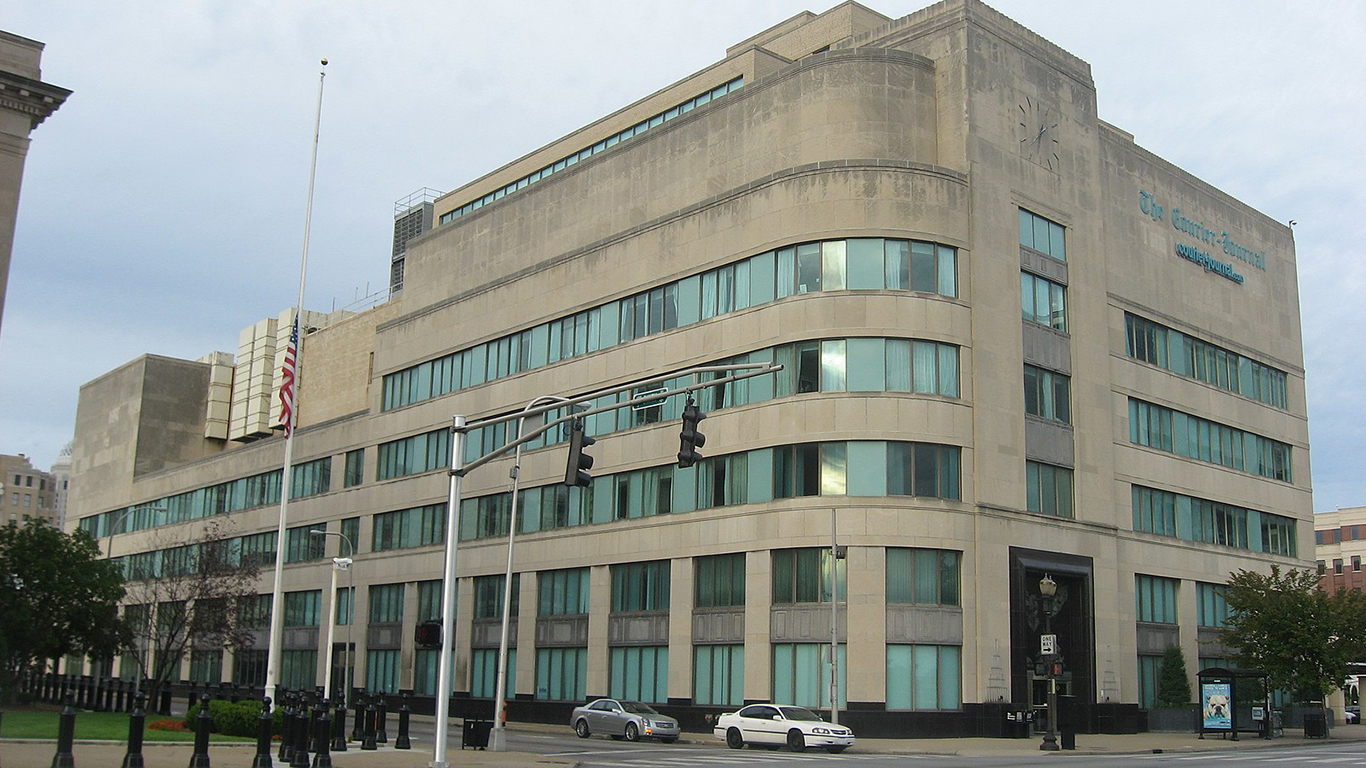
24. The Louisville Courier-Journal
> Year founded: 1826
> Place founded: Louisville, KY
> Original name: The Focus of Politics, Commerce and Literature
n 1826, a veteran publisher named William Worsley and a partner started the ambitiously titled Focus of Politics, Commerce, and Literature — later known simply as the Louisville Daily Focus — to compete with what was then the state’s most influential paper, the Louisville Public Advertiser.
A Connecticut journalist, George D. Prentice, came to Louisville to write a biography of his friend Henry Clay, who planned to run for president in 1832, but was pressed into service as editor of a new publication called the Louisville Journal, which first appeared in 1830. The Journal and the Focus merged briefly. Kentuckian Walter Newman Haldeman, who learned the newspaper business under Prentice at the Journal, bought a failing four-page paper called the Daily Dime in 1844, and when it was less than successful, transformed it into the Louisville Morning Courier.
The Journal and the Courier were bitter rivals until Prentice’s successor, Henry Watterson, approached Haldeman, suggesting a partnership between the two papers, saying “You need an editor, I need a publisher.” In 1868, they merged. Though Watterson was a Confederate veteran, he was an admirer of Abraham Lincoln and a proponent of African-American suffrage, and over his half-century career as Courier-Journal editor, he brought it national renown.
Haldeman launched the Louisville Times as an afternoon counterpart to the morning Courier-Journal in 1884. After his death in 1902, a former mayor of Louisville, Robert Worth Bingham, bought a controlling interest in both papers, and the Bingham family ran them until the company was sold to Gannett Co., proprietor of USA Today among many other publications and broadcast entities, in 1986. Gannett folded the Times folded the following year.
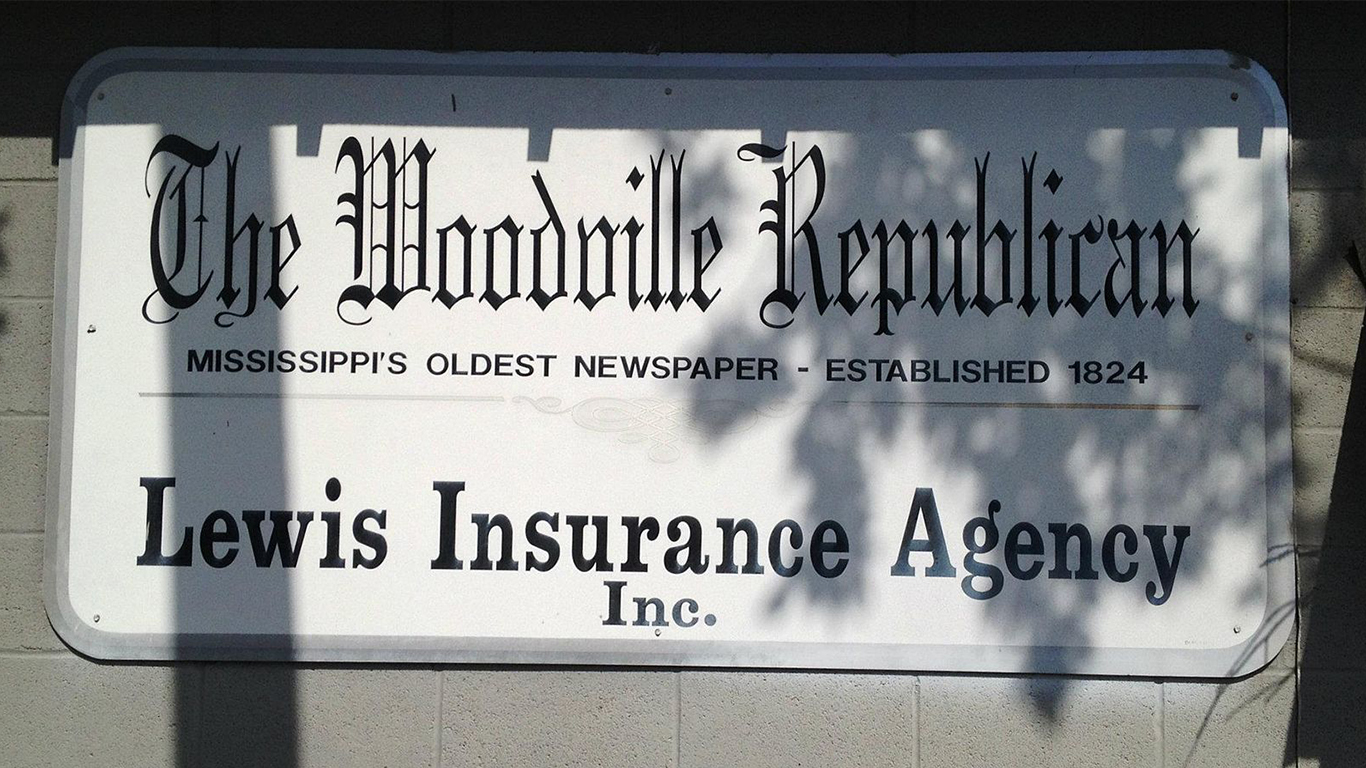
23. The Woodville Republican
> Year founded: 1823/1824
> Place founded: Woodville, MS
> Original name: The Woodville Republican
According to the historical marker in front of its old headquarters in Woodville, in the southwestern corner of Mississippi, the Republican is not only the oldest newspaper but also the oldest “business institution in continuous operation” in the state.
According to Mississippi historical resources, the paper was founded as a four-page weekly by William A. A. Chisholm, a transplanted Missourian, in 1823. On the basis of volume numbers, the paper itself claims 1824 as its birth year on its masthead. In any case, Chisholm ran it until 1842, and then, for the next 35 years or so, it had several owners and numerous editors.
Under both Chisholm and his successors, the paper changed names nine or ten times, reverting, around 1858, back to the Woodville Republican, where it has remained. In 1879, a Confederate veteran, Captain John South Lewis, purchased the Republican, and his descendents own it to this day.
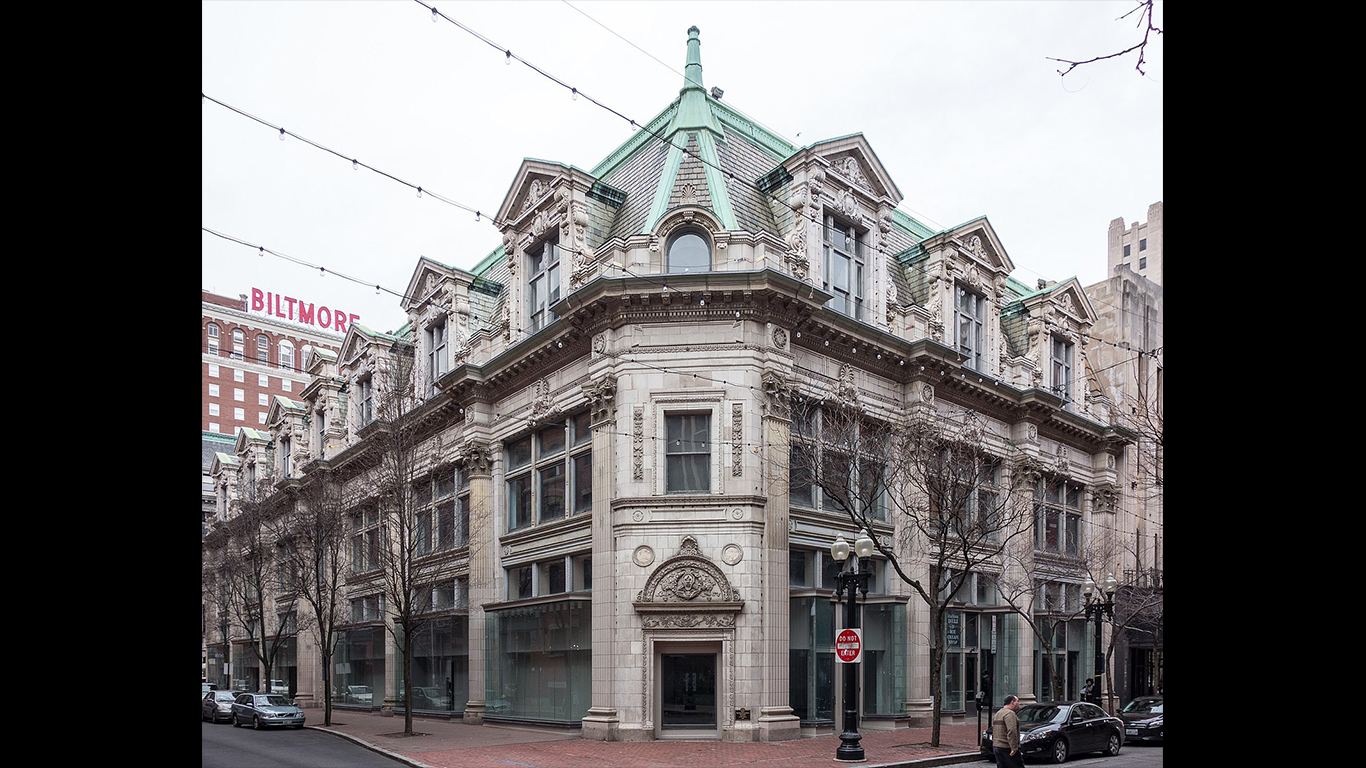
22. Providence Journal
> Year founded: 1820
> Place founded: Providence, RI
> Original name: The Manufacturers’ and Farmers’ Journal and Providence and Pawtucket Advertiser
A newspaper called the Providence Journal first appeared in 1799, but it died a few years later. Today’s Journal dates its birth to 1820, when a group of Providence industrialists and other prominent citizens invested in and/or advised on the creation of the twice-weekly Manufacturers’ & Farmers’ Journal.
The name was significant: Rhode Island had thrived on agriculture and commerce, but new industrial interests were becoming increasingly prominent, and other local publications theorized that the rise of manufacturing would mean the demise of the state’s earlier sources of prosperity. The new paper was dedicated to the proposition that manufacturing and farming could exist side by side.
The Journal was initially published by out of a local institution called the Old Coffee House by an experienced printer, “Honest John” Miller, and his business partner, a bookbinder named John Hutchens. Miller bought out his partner in 1823, and in 1829 turned the publication into Rhode Island’s first daily newspaper, renaming it the Providence Daily Journal and General Advertiser. Miller sold the paper seven years later, and it had several changes of ownership over the next three decades, ending up in the hands of newspaperman George W. Danielson and the son of a textile mill owner, Henry B. Anthony — later to become governor of Rhode Island and a U.S. senator from the state.
Along with a sister paper, the Evening Bulletin, established in 1863, the Journal became part of the Providence Journal Company, established by the families of Danielson and Anthony after their deaths. The families retained their interest in the company until 1996, when it was sold to Dallas-based A. H. Belo Corporation, which owns the Dallas Morning News. In 2014, Belo sold the Journal Company to New Media Investment Group, Inc., parent company of GateHouse Media.
[in-text-ad-2]
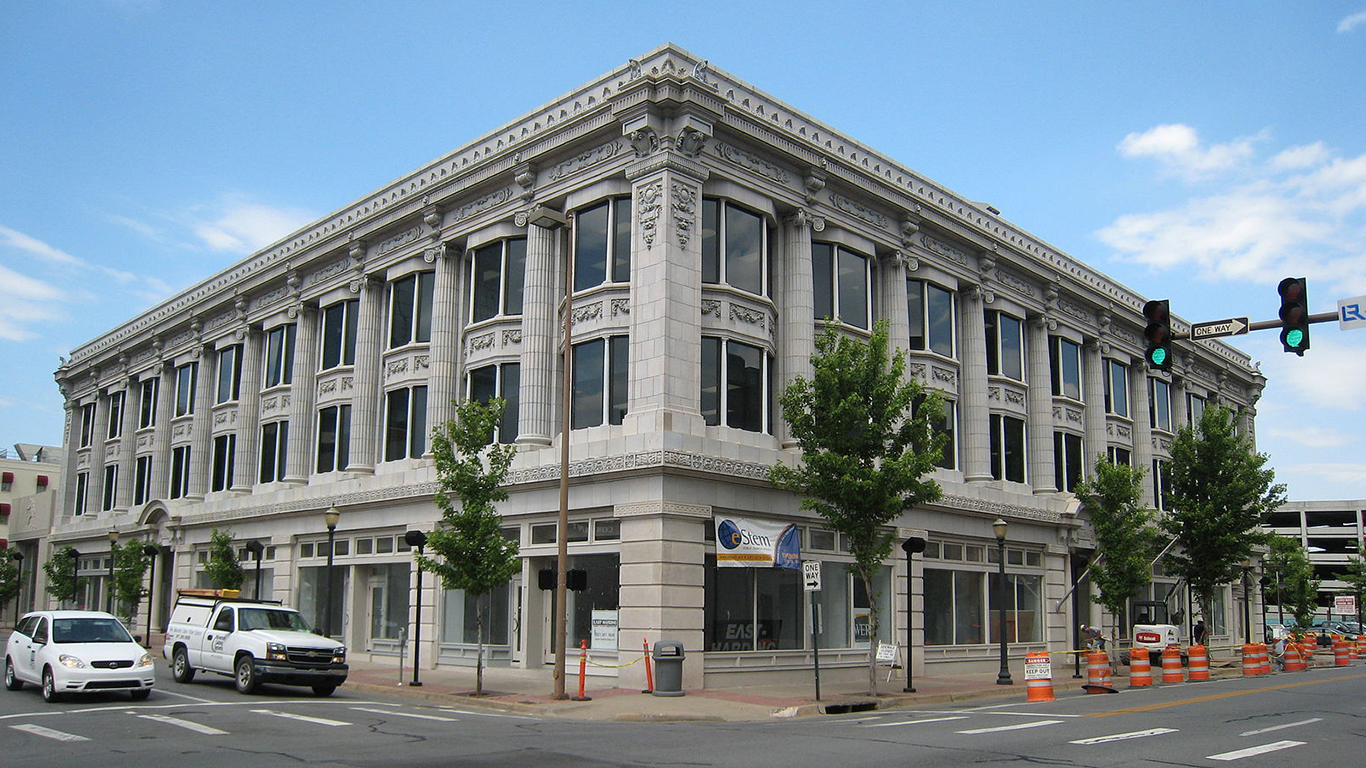
21. Arkansas Democrat-Gazette
> Year founded: 1819
> Place founded: Arkansas Post, AR
> Original name: The Arkansas Gazette
Arkansas Post was a trading post built by the French in 1686 at the confluence of the Arkansas and Mississippi rivers — the first European settlement in what was to become the Arkansas territory and then the state of Arkansas. The post subsequently moved up and down the Arkansas several times, and in 1819, a young transplanted New Yorker named William E. Woodruff, who had apprenticed with book and newspaper publishers in his native state, arrived there with a small printing press. He began publishing a weekly newspaper, the Arkansas Gazette, moving it to Little Rock when that became the territorial capital in 1821.
Woodruff lost control of the paper in the 1830s, and launched a competing publication, the Arkansas Democrat, in 1846. He bought the Gazette back in 1850 and united both newspapers as the Arkansas State Gazette and Democrat, later just the Arkansas State Gazette. His Democrat is not related to the present-day paper, though.
During the period of Reconstruction, following the Civil War, two Arkansas newspaper editors, John P. Jones and William J. Buchanan, began publishing a Little Rock weekly called the Liberal, whose motto was “The World Is Too Much Governed.” An Irishman named Dan O’Sullivan launched the Evening Star. In 1878, this in turn was bought by a former Confederate Officer, Colonel J. N. Smithee, who renamed it the Arkansas Democrat.
For more than a century, the Democrat and the Gazette were rivals, often bitter (at one point, Smithee was wounded in a shoot-out with one of the Gazette’s owners), and both papers changed hands more than once. Publishing giant Gannett (proprietors of USA Today and more than 125 other newspapers and websites nationwide) bought the Gazette in 1986, and five years later shut it down. The Democrat immediately bought the defunct paper’s assets and renamed itself the Democrat-Gazette. Today, the Democrat-Gazette is wholly owned by the Little Rock-based WEHCO Media, Inc., whose founder, Walter E. Hussman, originally bought the paper in 1974.
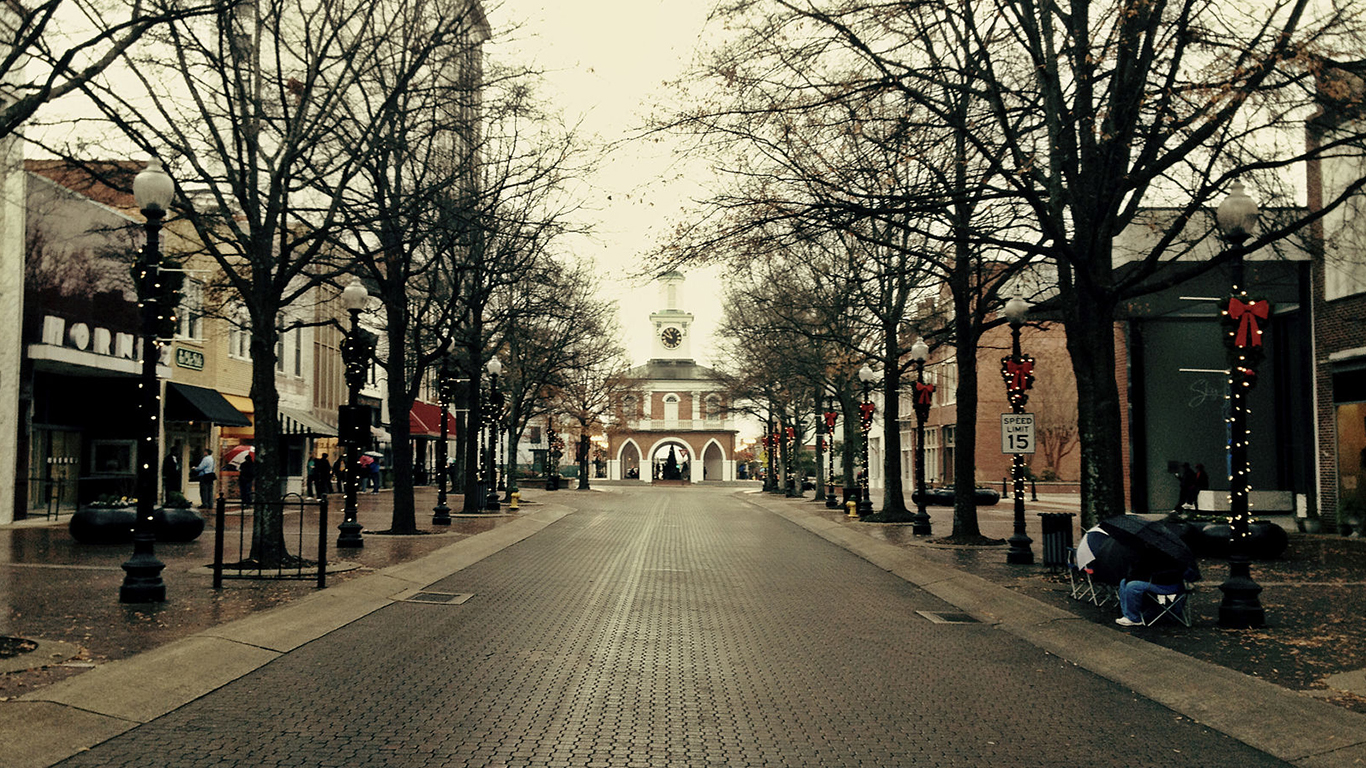
20. The Fayetteville Observer
> Year founded: 1816
> Place founded: Fayetteville, NC
> Original name: Carolina Observer
In 1816, one Francis W. Waldo — possibly a former reporter from Massachusetts — founded a four-page weekly called the Carolina Observer in Fayetteville, south of Raleigh, North Carolina.
Eight years later, a newspaper veteran named Edward Jones Hale bought it, publishing his first issue in 1825 and remaining the paper’s owner and editor for the next 40 years, changing its name to the Fayetteville Observer in 1833.
Hale’s sons, Peter Mallett, Edward Joseph, and Edward Jones, Jr., joined the paper in 1850. The Observer was staunchly pro-Confederate during the Civil War, and in 1865, General Sherman ordered his troops to burn the paper’s offices and presses. Hale and his sons moved to New York City, where they started a book publishing business. In 1883, Edward Jones, Jr. returned to Fayetteville and relaunched the Observer, and it stayed in the Hale family until 1919.
In 1923, after several brief ownership changes, it was bought by a New York City newspaperman named William James McMurray, who gave it over the following year to his brother-in-law, Charles Wilson. Wilson’s son-in-law, Richard Lilly, became publisher, and was succeeded in turn by his own son-in-law, Ramon Yarborough.
Yarborough launched a new local paper, the Fayetteville Times, while continuing to run the Observer, and the two publications merged in 1990. In 1999, the Times reclaimed its historic name, becoming the Fayetteville Observer once more. Yarborough retired in 2000, and his place was taken by Charles W. Broadwell, a great-grandson of Charles Wilson. The GateHouse chain bought the Observer in 2016.
[in-text-ad]
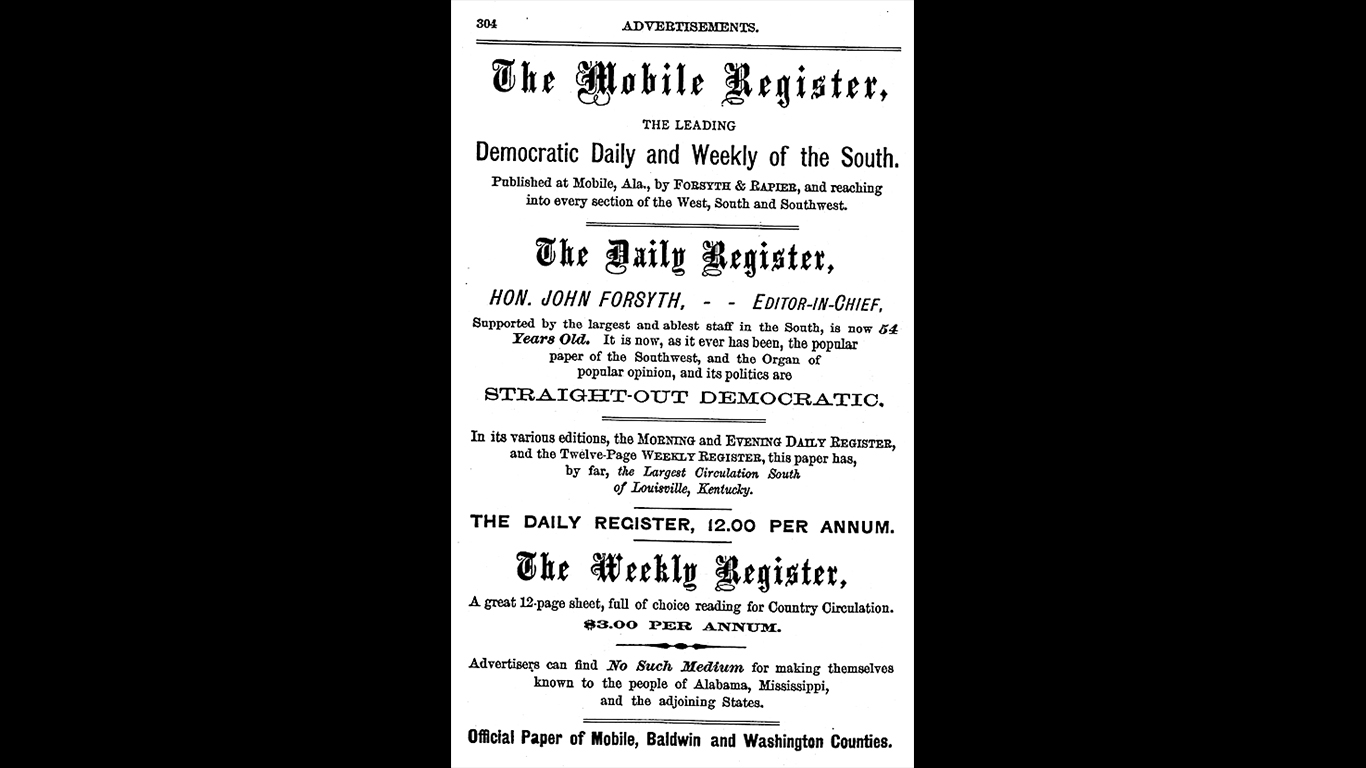
19. Alabama Press-Register
> Year founded: 1813
> Place founded: Mobile, AL
> Original name: The Mobile Gazette
James Lyon, the eldest son of an Irish immigrant who became a printer-publisher in Vermont and later a U.S. congressman, founded newspapers in Vermont, Virginia, Georgia, Louisiana, and Washington, D.C. before ending up in Mobile, Alabama, where he created the Mobile Gazette in 1813.
In 1821, a Boston-born Savannah merchant, Jonathan Battelle, joined forces with an Alabama newspaperman, John W. Townsend, to found a rival publication, the Mobile Commercial Register. After publishing the Gazette for several years, Lyon moved on to South Carolina, where he founded yet another paper, and the Register absorbed the Gazette.
There were frequent ownership changes over the next century, and the Register changed names several times, along the way subsuming four other local papers. In 1929, Ralph B. Chandler, a former advertising manager of the Cincinnati Post, began publication of the Mobile Press. He was successful enough to be able to buy the Register three years later, keeping the two separate during the week — the Register in the morning, the Press in the evening — with a combined Sunday edition called the Press-Register.
S.I. Newhouse’s Advance Publications, Inc. bought the papers in 1966, folding the afternoon Press in 1997 and combining the Press-Register with its two other Alabama papers, the Birmingham News and the Huntsville Times, under the Alabama Media Group umbrella in 2012. What is now the Alabama Press-Register has an online presence through AL.com and publishes a print edition on Wednesdays, Fridays, and Saturdays.
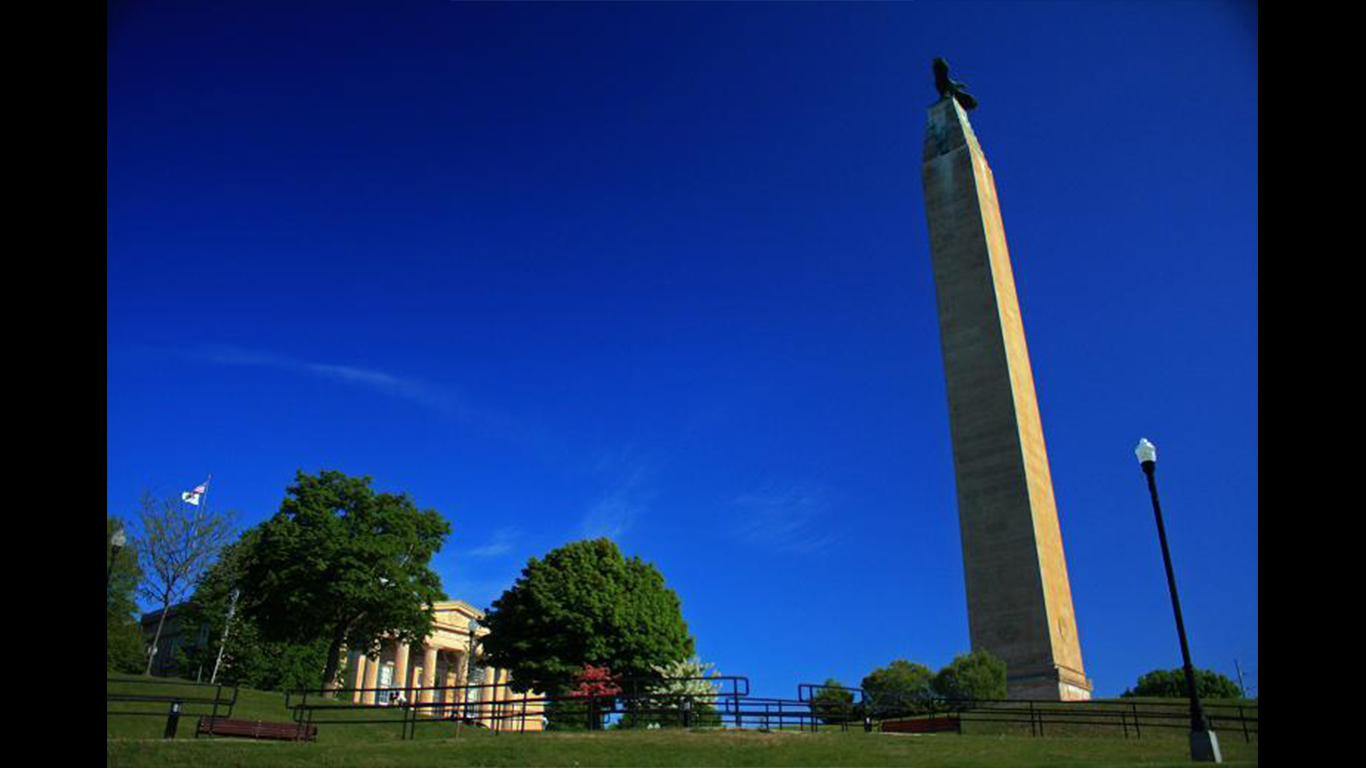
18. The Press-Republican
> Year founded: 1811
> Place founded: Plattsburgh, NY
> Original name: The Republican
In 1809, a man named Samuel Lowell launched a newspaper called the American Monitor, supporting the Republican — then the Democratic-Republican — Party, in the northeastern New York state town of Plattsburgh. When Lowell got married in 1811, however, he converted to the rival Federalist Party views of his wife’s family and began attacking the Democratic-Republican president, James Madison, in print. The party was outraged and met to organize the publication of a paper that would espouse their cause.
The secretary and editor of the new enterprise — a weekly called simply the Republican — was Colonel Melancton Smith, a strong anti-Federalist. Two years later, Azariah Cutting Flagg, a so-called radical Democrat-Republican who had helped print the original publication, took over the editorship, and the paper became the Plattsburgh Republican.
A rival paper, the Plattsburgh Daily Press, appeared in 1895, publishing six days a week. The Republican remained weekly until 1916, when it, too, began publishing six issues weekly, renaming itself the Plattsburgh Daily Republican. (Amusingly, despite its name, it styled itself “The official Democratic newspaper of Clinton County and the city of Plattsburgh.”) In 1942, the papers merged, becoming the Plattsburgh Press-Republican. Today, it belongs to CNHI LLC, an Alabama-based company that operates more than a hundred community newspapers in 22 states.
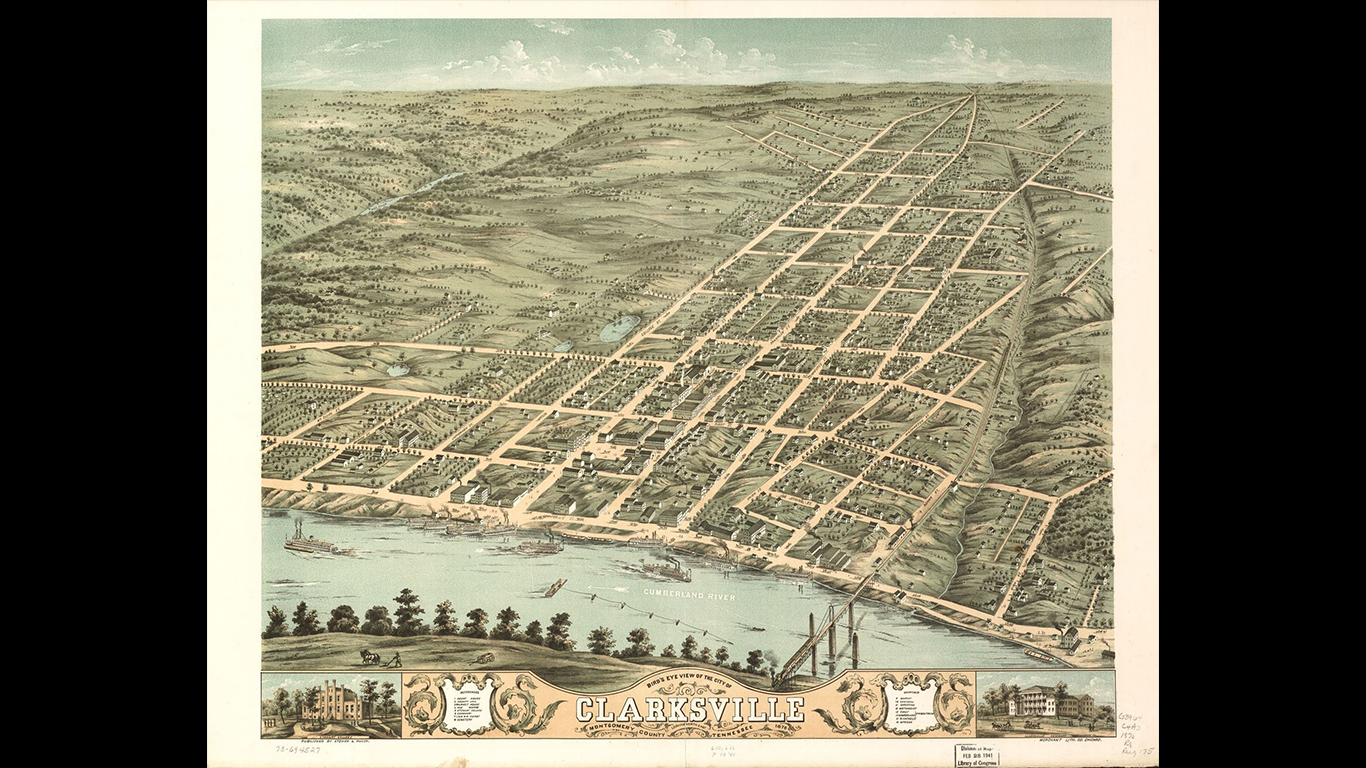
17. The Leaf-Chronicle
> Year founded: 1808(?)
> Place founded: Clarksville, TN
> Original name: Clarksville Chronicle
It’s sometimes claimed that the Clarksville Chronicle was first published, in this Tennessee city on the Kentucky border, northwest of Nashville, in 1808. However, the earliest extant copies of the paper date from 1818, and the volume numbers suggest a launch date of 1815 — and a story from 1993 in its offspring, the Leaf-Chronicle, admits that “Little is known concerning the operation of the paper in its earliest years.”
The mystery continues: Founding of the Chronicle is usually credited to George Crutcher, who was probably the son of a one-time Clarksville city clerk, along with an associate, William Kendall. It’s also possible, though, that it was started by Francis Richardson, possibly the publisher of another local paper, the Rising Sun. Ewing P. McGinty, who later edited the Nashville True Whig, oversaw the Chronicle from 1836 until 1849, when the post was taken over by Robert Warner Thomas, who became renowned throughout the state for his political articles, which were often reprinted by other publications.
The Chronicle — which went through several name changes in the 1850s and ’60s — suspended publication during the Civil War, starting up again in 1865. In 1869, a new publication, the Tobacco Leaf, appeared in Clarksville. Launched by M. V. Ingram, who had started another paper in nearby Springfield, it was dedicated to supporting the local tobacco industry. The two papers were on different sides politically, and for years were strenuous competitors. In 1878, however, a huge fire destroyed about a third of Clarksville, including the Tobacco Leaf offices, and the owners of the Chronicle offered their rival use of their facilities.
Ingram sold the Tobacco Leaf in 1881, while the Chronicle underwent several changes of management over the years. In 1890, the new owners of the Tobacco Leaf purchased the Chronicle and began publishing the Clarksville Tobacco Leaf Chronicle. “Tobacco” was dropped from the name, and in the late 1970s, reflecting the paper’s broader reach, so was “Clarksville.”
Multimedia, Inc., a South Carolina-based media company, bought the paper in 1974. USA Today parent, Gannett Co., in turn bought Multimedia in 1995 and now owns the Leaf-Chronicle.
[in-text-ad-2]
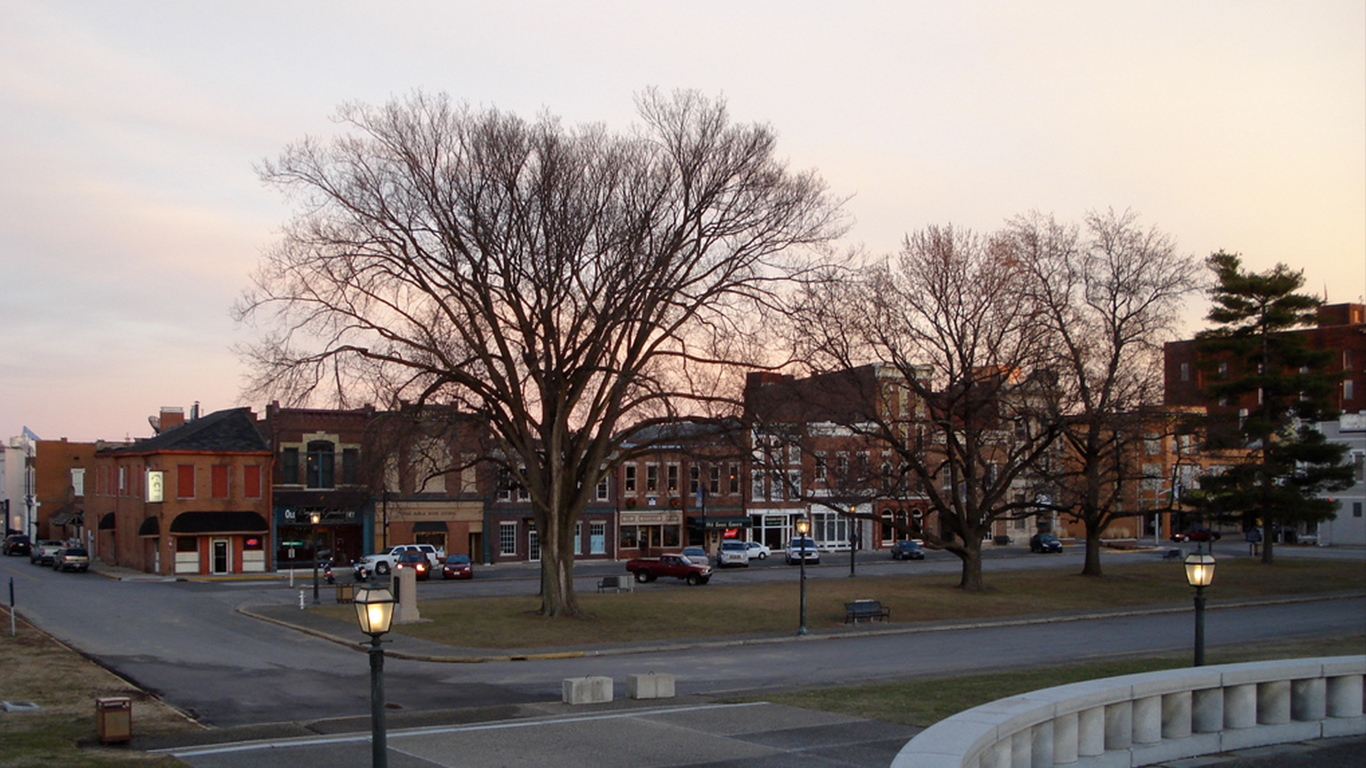
16. Vincennes Sun-Commercial
> Year founded: 1804
> Place founded: Vincennes, IN
> Original name: Indiana Gazette
In 1804, the governor of the Indiana Territory — William Henry Harrison, who would later become the ninth president of the United States (and die of pneumonia after only a month in office) — offered a salary of $500 a year to any printer who would set up shop in Vincennes, the territorial capital, to publish laws and legal advertisements. A young journeyman printer from New Jersey, Elihu Stout, got the job, and published the first issue of what he dubbed the Indiana Gazette on the Fourth of July, 1804.
The Gazette offices were destroyed by fire in 1806, and Stout was out of business for a year, but he returned with a new paper, the Western Sun. Stout continued to run the publication, changing its name to the Western Sun and General Advertiser in 1817. According to local legend, a 21-year-old Abraham Lincoln stopped by the office on his way from Indiana to his new home in Illinois and helped print the edition of March 6, 1830.
Stout sold the Sun to John R. Jones, former publisher of the People’s Friend in Covington, Kentucky, in 1845. He changed the name several times before selling it in turn, in 1856, to George E. Green, who restored its former name. Several other owners took it over, one of whom, R. E. Purcell, started a second paper called the Vincennes Sun.
Another local publication, the Vincennes Commercial, appeared in 1877. The paper attracted attention in the 1920s for its campaign against the Ku Klux Klan, which had become important politically in Indiana. In 1930, newspaper publisher Eugene C. Pulliam, founder of Central Newspapers, Inc., bought the papers, merging them in 1931. Gannett, owners of USA Today and many other media properties, bought Central — and the Sun-Commercial — in 2000.

15. The Post and Courier
> Year founded: 1803
> Place founded: Charleston, SC
> Original name: The Courier
A young Massachusetts printer named Aaron Smith Willington moved to Charleston in 1802 to help Loring Andrews, who had become a prominent printer in Albany, New York, launch a newspaper in the South Carolina city. The first issue of the paper, called the Courier, carried the credit “By A. S. Willington for Loring Andrews.” Andrews left to return north in 1805, and the following year, Willington became an owner of the publication, renamed the Charleston Daily Courier in 1852. Willington remained with it, becoming senior editor and sole proprietor, until his death in 1862.
In the years leading up to the Civil War, the Courier opposed secession at first, and later advocated it but counseled moderation. Nonetheless, it was seized by the Union army towards the end of the war and briefly published as a “loyal Union newspaper” by two Union war correspondents. In late 1865, control of the Courier was given to back to the Willington company, with a former Confederate officer, Thomas Y. Simons, put in charge.
Also in 1865, a new local paper, the Charleston Daily News, was launched by two South Carolinians and a New Yorker. Two years later, they sold it to another partnership, which bought the Courier in 1873 and renamed their publication the News and Courier.
Still another Charleston newspaper, the Evening Post, was founded in 1894 by Hartwell M. Ayer. Wealthy rice planter Arthur Manigault assumed control in 1896, and in 1926, two years after his death, his family bought the News and Courier. The Manigaults continued to publish both papers, the News and Courier in the morning and the Evening Post in the afternoon. The staffs of the two were combined in the 1980s, and they formally merged in 1991 as the (morning) Post and Courier. Evening Post Enterprises, still under the leadership of the Manigault family, owns the paper as well as numerous other publications, TV stations, a forestry operation, and health care facilities.
[in-text-ad]

14. New York Post
> Year founded: 1801
> Place founded: New York, NY
> Original name: The New York Evening Post
New York’s favorite tabloid newspaper, famed for such sensationalist headlines as “Khadafy Killed by Yankee Fan,” “My Doctor Has Ebola,” and the immortal “Headless Body in Topless Bar” and its gossipy Page Six section, was created by Founding Father and one-time Secretary of the Treasury (and latter-day Broadway musical star) Alexander Hamilton.
Hamilton thought there should be a publication that espoused his Federalist views. William Coleman, an attorney from Greenfield, Massachusetts, who had earlier financed that town’s first newspaper, the Impartial Intelligencer (an ancestor of the Recorder; see No. 10), knew Hamilton. Having newspaper experience, he offered to help him and his colleagues establish a new publication. A meeting was held, probably at the home of a wealthy merchant named Archibald Gracie (the house, now called Gracie Mansion, has become the official residence of the mayor of New York City). The first issue of what they called the Evening Post, which appeared in November of 1801, was written by Coleman, probably with Hamilton’s help.
Coleman — who, coincidentally, had once briefly been a law partner of Aaron Burr, later to kill Hamilton in a famous duel — remained editor of the paper until his death in 1829. He was succeeded by Massachusetts poet William Cullen Bryant, who held the post for 50 years. The next illustrious figure to hold the post was journalist-turned-railroad-tycoon Henry Villard, who bought the Post in 1881.
The paper, which became known simply as the New York Post, had several owners between 1917 and 1939, when it became the property of a wealthy, socially prominent New Yorker, Dorothy Schiff. A friend of Franklin Roosevelt, Nelson Rockefeller, and John F. Kennedy, among many others, Schiff struggled to keep the Post alive and thriving, sometimes successfully. By the mid-1970s, however, the paper was losing money, and in 1976, Schiff sold it to controversial Australian-born media mogul Rupert Murdoch, whose company still owns it.
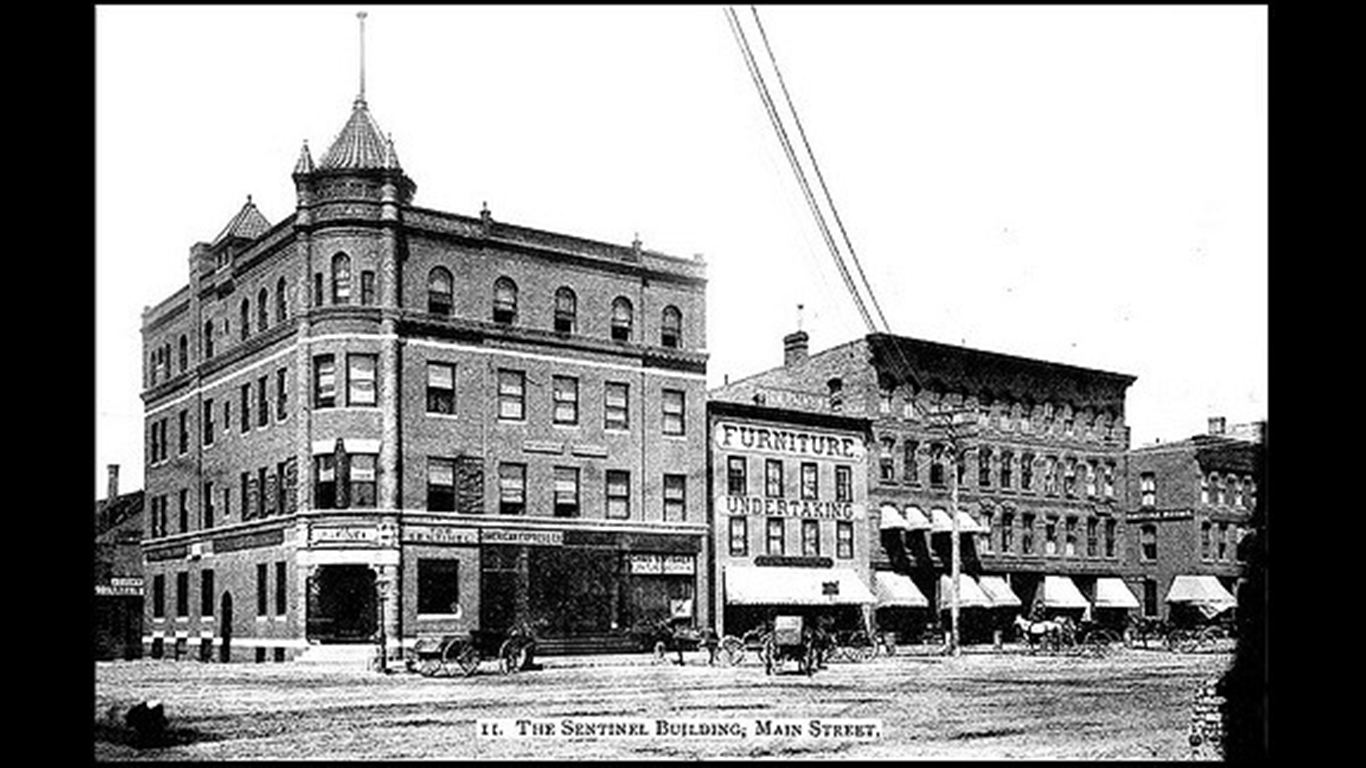
13. The Keene Sentinel
> Year founded: 1799
> Place founded: Keene, NH
> Original name: The New Hampshire Sentinel
There had already been four weekly newspapers published in Keene, in southwestern New Hampshire, when a printer from Massachusetts, John Prentiss, set type for the first issue of his first newspaper, which he called the New Hampshire Sentinel. Prentiss’s brother and son both worked for him, and when the senior Prentiss retired in 1847, his son took on a partner, Albert Godfrey.
Several ownership changes took place over the following three decades — at one point, the celebrated author and educator George Ticknor was an owner — and in 1880, founder John Prentiss’s grandson, William H. Prentiss, became part owner and city editor. He and then his descendants owned the paper until 1954, when it was sold to James D. Ewing, one-time proprietor of the Bangor Evening Commercial in Maine, and Baltimore Sun editorial writer Walter Paine.
In 1957, the paper merged with the afternoon paper the Prentisses had launched in 1930, the Keene Evening Sentinel, and the Keene Sentinel was born. A rarity among American newspapers today, the Sentinel remains in local hands: James Ewing’s nephew Thomas, whose family runs newspapers in upstate New York, bought it in 1993 and is still the owner and publisher.
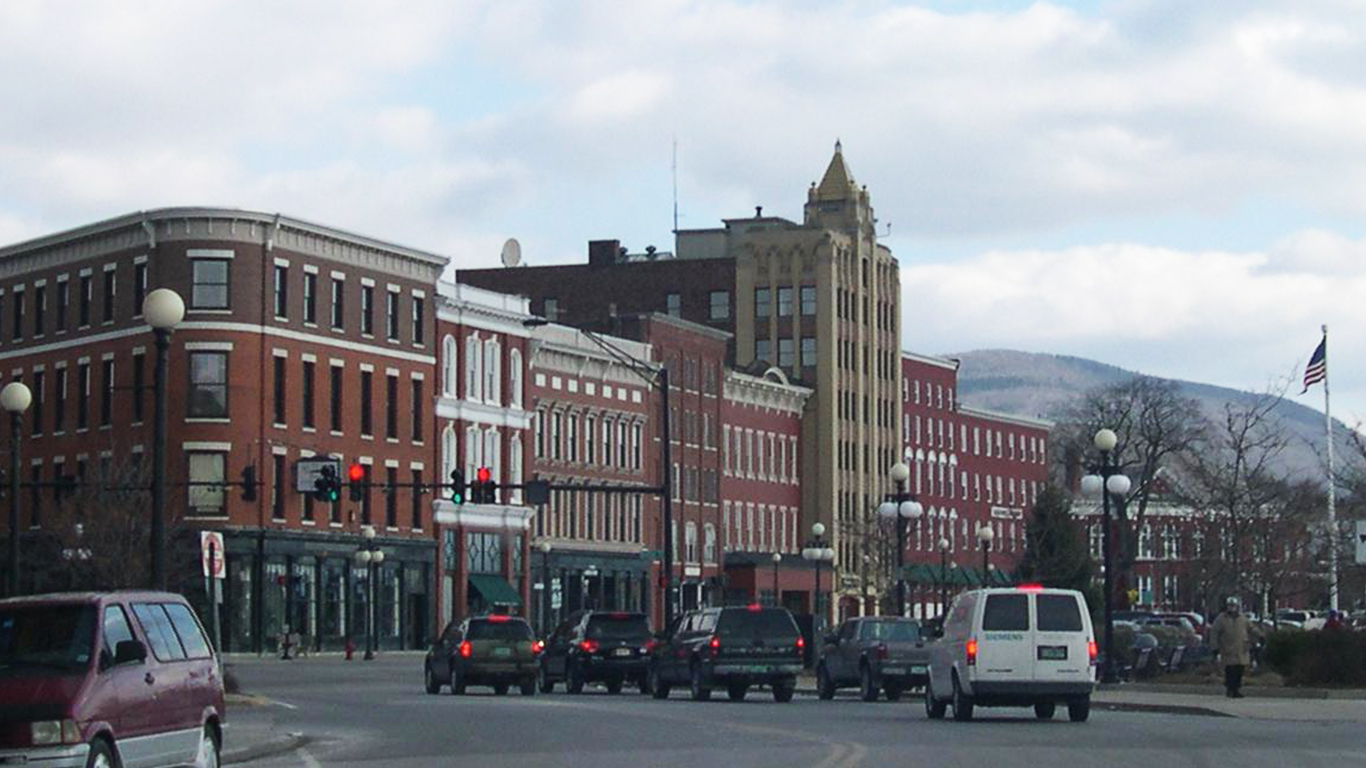
12. The Rutland Herald
> Year founded: 1794
> Place founded: Rutland, VT
> Original name: The Rutland Herald
The Rutland Herald was founded by two men with the same name: the Reverend Samuel Williams and his friend and distant cousin, attorney and judge Samuel Williams. The Reverend graduated from Harvard University and became a professor there, but in 1788 was accused of misusing university funds and fled to Vermont. (Vermont declared itself an independent republic in 1771 — 20 years before it was to become a state — and would not extradite fugitives.)
The other Williams was later named Vermont’s official state printer for the area west of Green Mountains, and in 1794 he collaborated with the reverend in launching the Herald. The partnership dissolved in 1797, when the judge retired to run for Congress, and a Massachusetts printer, William Fay, became the reverend’s new partner. Williams left the paper in 1805, but Fay remained, with various partners, until 1840, filling the Herald’s pages with biblical parables and homilies.
The paper became the Rutland Daily Herald in 1861, and it had various owners throughout the rest of the 19th century and the early years of the 20th. In 1927, it was taken over by Rutland native William H. Field, who had earlier founded the paper which became the New York Daily News. In 1947, it was sold to a well-known Vermont reporter, Robert W. Mitchell. Mitchell’s son continued to publish the Herald until 2016, when it was bought by Maine media mogul Reade Brower and New Hampshire businessman Charles “Chip” Harris. Earlier this year, it was sold yet again, to Sample News Group, which owns 75 publications in six states.
Frequent ownership changes notwithstanding, The Rutland Herald remains the oldest continuously published local newspaper in the United States under the same name in the same city.
[in-text-ad-2]

11. LNP
> Year founded: 1794
> Place founded: Lancaster, PA
> Original name: The Lancaster Journal
A Philadelphia printer named William Hamilton, in partnership with Henry Willcocks, a newspaperman from nearby York, Pennsylvania, launched the Lancaster Journal in 1794 with the motto “Not too RASH — yet not FEARFUL — Open to all PARTIES but not influenced by ANY.” Willcocks left after a couple of years, but Hamilton, who later served as a state senator and published the first German-English dictionary in America, edited the paper until 1820.
A competitor, the Lancaster Intelligencer & Weekly Advertiser, had been founded in 1799, and it merged with the Journal in 1839, creating the Lancaster Intelligencer & Journal. In the mid-1800s, a number of other newspapers were started up in Lancaster, one of which, the Weekly Express, was edited by J. M. W. Geist, who had begun his journalistic career editing and publishing a temperance journal. In 1877, he and an attorney and politician named John B. Warfel established the Lancaster New Era.
The owner of the Intelligencer bought the Lancaster Journal in 1839. In 1865, when the paper encountered financial difficulties, Andrew Jackson Steinman, whose father owned the city’s leading hardware store, became an investor, taking it over completely a year later with a partner.
This was the beginning of a long Steinman family relationship with the publication. In 1909, they relaunched the Journal as a morning paper, with the Intelligencer appearing in the afternoons. In 1928, the Steinmans bought the New Era, making that their afternoon flagship and combining the Journal and the Intelligencer again as a morning paper. In 2009, the New Era was folded in to create the Intelligencer Journal/Lancaster New Era.
Steinman Communications’ LNP Media Group Inc., which owns other Pennsylvania media properties and other businesses, renamed the paper LNP (presumably standing for Lancaster News Paper — the company doesn’t specify) in 2014.
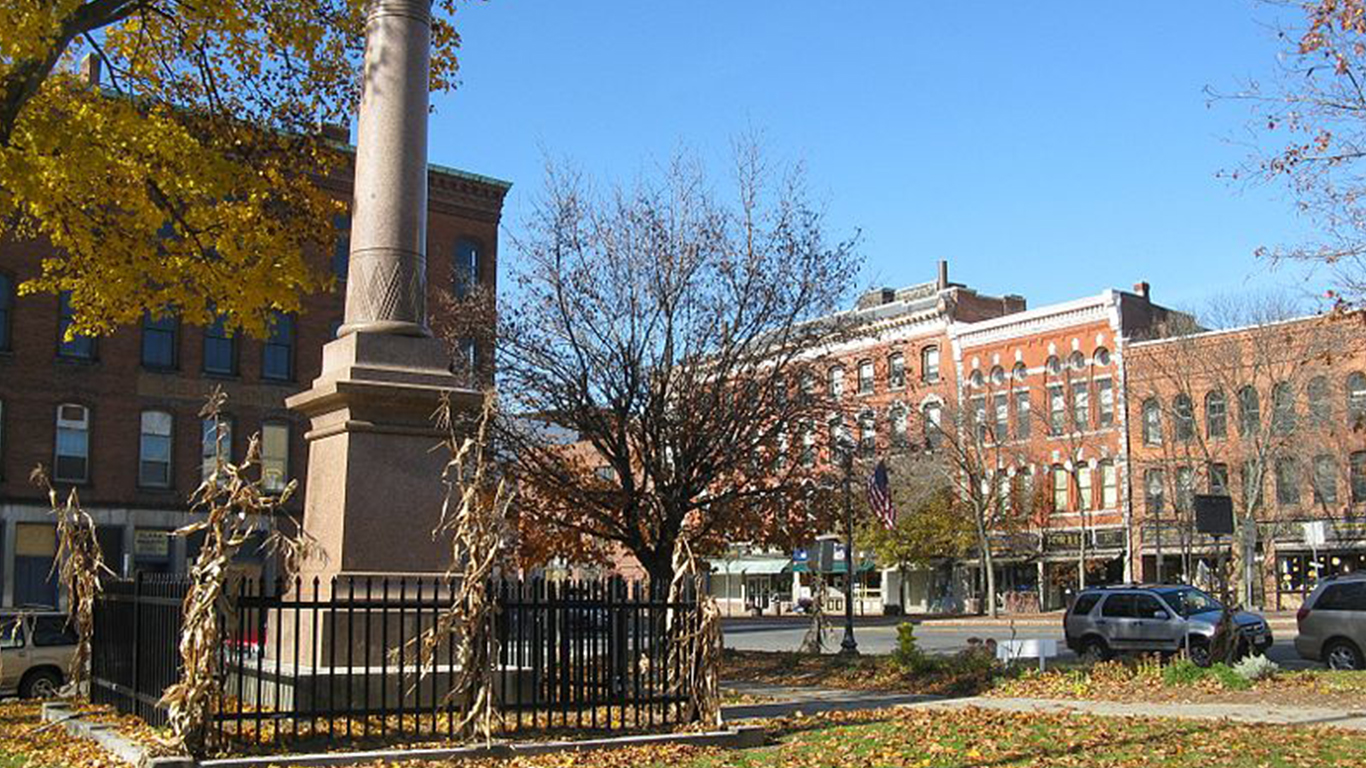
10. The Recorder
> Year founded: 1792
> Place founded: Greenfield, MA
> Original name: The Impartial Intelligencer
William Coleman, the first attorney in this town in Hampshire County, in northwestern Massachusetts (and the man who was later to co-found the New York Post with Alexander Hamilton; see No. 14), wanted to publish a record of current events in the area. In 1792, he brought a journeyman printer, Thomas Dickman, from Worcester to edit his journal, which was dubbed the Impartial Intelligencer.
New owners in 1811, after Hampshire County had been divided and Franklin County created, renamed it the Franklin Herald. Later name changes included the Advertiser, the Franklin Freeman, and the Greenfield Gazette & Courier. An editor at the Gazette & Courier, Herbert Collins Parsons, who had been a state senator and congressman, founded a rival paper, the Greenfield Recorder, in 1900. In 1932, it merged with the Gazette and Courier as the Greenfield Recorder-Gazette.
The paper was bought in 1955 by Henry J. Conland and William Dwight Sr., and the Dwight family still owns it as part of their Newspapers of New England group, which also owns several other dailies, weeklies, and associated properties in Massachusetts and New Hampshire. In 1964, the word “Gazette” was removed from the Greenfield paper’s name, and in 1985, the publishers took “Greenfield” out, too, to reflect its coverage of an area beyond just that city.
[in-text-ad]
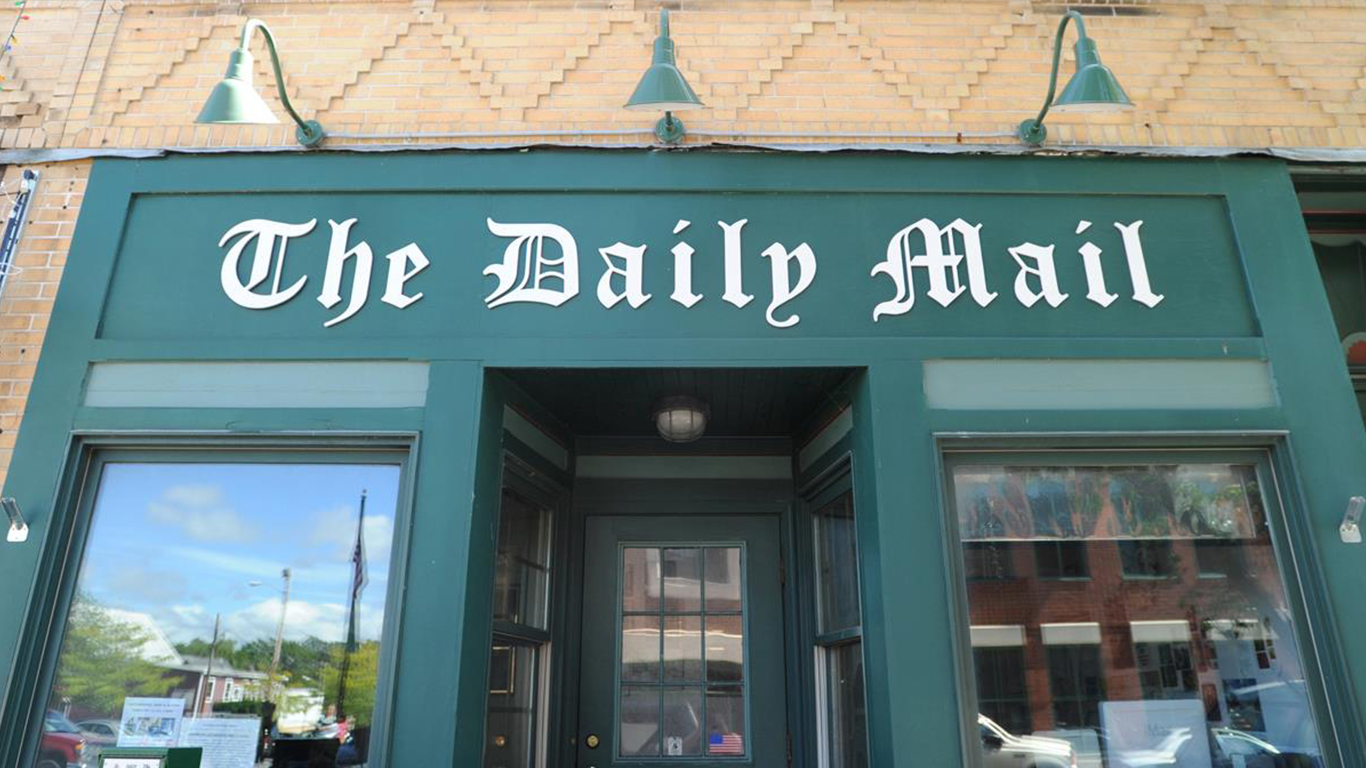
9. The Daily Mail
> Year founded: 1792
> Place founded: Catskill, NY
> Original name: The Catskill Packet
The Daily Mail’s earliest direct ancestor is the Catskill Packet, which first appeared in 1792, under the direction of brothers Thomas and Mackay Croswell (Mackay had earlier apprenticed at the Connecticut Courant; see No. 1). It subsequently became the Catskill Packet, & Western Mail, then the Catskill Packet again, before suspending publication temporarily in 1797 and folding in 1799.
Another Croswell brother, Harry, joined Mackay to edit a continuation of the Packet called the Catskill Western Constellation from 1800 to 1801. This evolved into the Catskill Recorder in 1804, which went on to absorb several other local newspapers — the Greene County Republican, the Catskill Democrat, and the American Eagle. By 1871, it had become simply the Recorder.
A former postmaster, John D. Smith, founded the Catskill Morning Mail, later the Daily Mail, in 1879. The Recorder, meanwhile, merged with the 1830-vintage Catskill Examiner in 1938, becoming the Examiner-Recorder. This became the Greene County News in 1962, and this in turn was taken over by the Daily Mail in 2003. Today, it belongs to the Hudson, New York-based Columbia Greene Media Corp., an advertising agency and digital and print publisher with several other properties in the Catskills area.
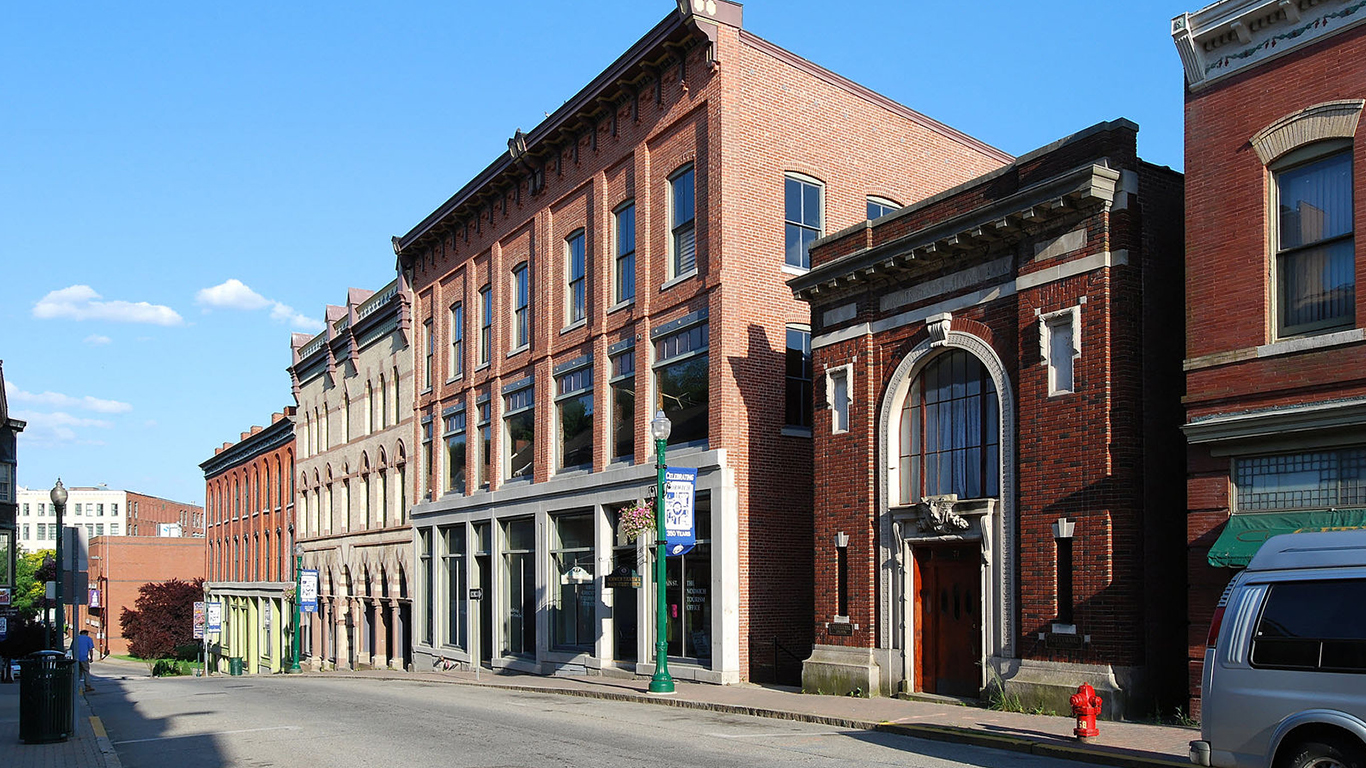
8. The Bulletin
> Year founded: 1791 (?)
> Place founded: Norwich, CT
> Original name: The Weekly Register (?)
In late 1791, Ebenezer Bushnell — a native of Lebanon, Connecticut, described in a 1903 volume called “Biographical Sketches of the Graduates of Yale College” as “a man of mechanical genius, quick wit, and varied information” — founded The Weekly Register in Norwich, in Connecticut’s New London County. About six months later, Bushnell’s brother-in-law, Thomas Hubbard, joined him in “a partnership in the Printing and Stocking-weaving business” (according to “American Biography” by Charles Evans, published in 1914). The following year, Bushnell left the paper, and Hubbard continued publishing it until 1796, when he moved to the Chelsea Landing area of Norwich and converted the Register to the Chelsea Courier.
The Courier continued, under various names and ownerships, until 1860. Two years earlier, the company that then owned the Courier, which appeared in the afternoon, decided that a morning paper would be more successful and launched the Norwich Morning Bulletin. In 1863, a group of local businessmen, probably led by banker Lorenzo Blackstone and cotton manufacturer John F. Slater, formed a stock company to take over the publication. In 1895, the owners renamed it simply the Norwich Bulletin.
The paper appeared under that name until 2011 under various owners — including Gannett Co., which bought it in 1981 and GateHouse Media (its current owners), which purchased it from Gannett in 2007. In 2011, GateHouse renamed it the Bulletin.
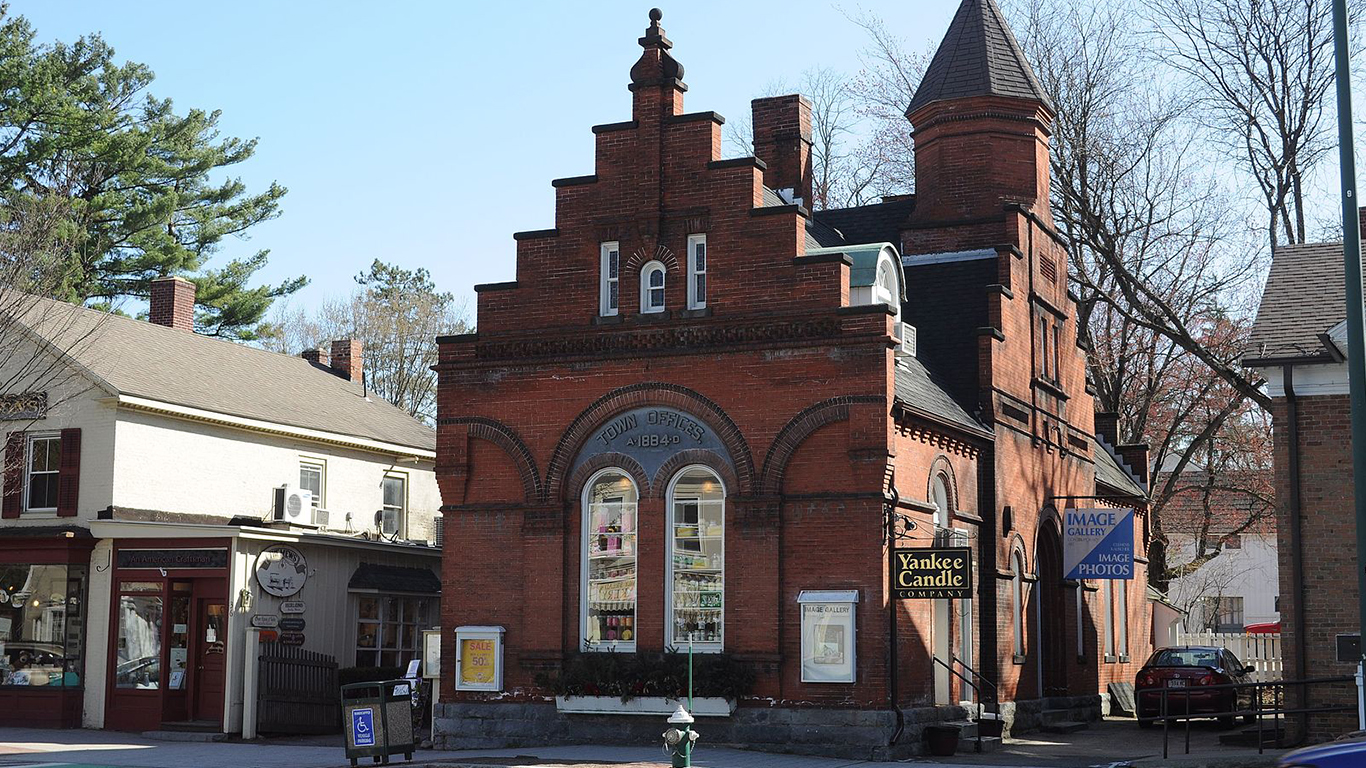
7. The Berkshire Eagle
> Year founded: 1789
> Place founded: Stockbridge, MA
> Original name: The Stockbridge Star
Printer Loring Andrews began publishing the Western Star (not the Stockbridge Star, as some sources report) in the town of Stockbridge, in the Berkshires of Massachusetts, in 1789. This became Andrews’s Western Star, and then the Berkshire Star. In 1828, the owners of the paper moved it to nearby Lenox and renamed it the Star and County Republican. The following year, a new owner renamed it the Berkshire Journal, and two years after that consolidated it with the Argus, published in another Berkshire town, Pittsfield.
The paper appeared as the Journal and Argus until 1834, when it was renamed the Massachusetts Eagle. This became the Berkshire County Eagle and then, in 1892, after Kelton B. Miller — later to become the mayor of Pittsfield — bought it, simply the Eagle. Miller’s descendents continued to run the Eagle until 1995, when the family sold it, along with several papers they owned in Vermont, to Denver-based MediaNews Group, Inc., now Digital First Media, which retains proprietorship.
[in-text-ad-2]
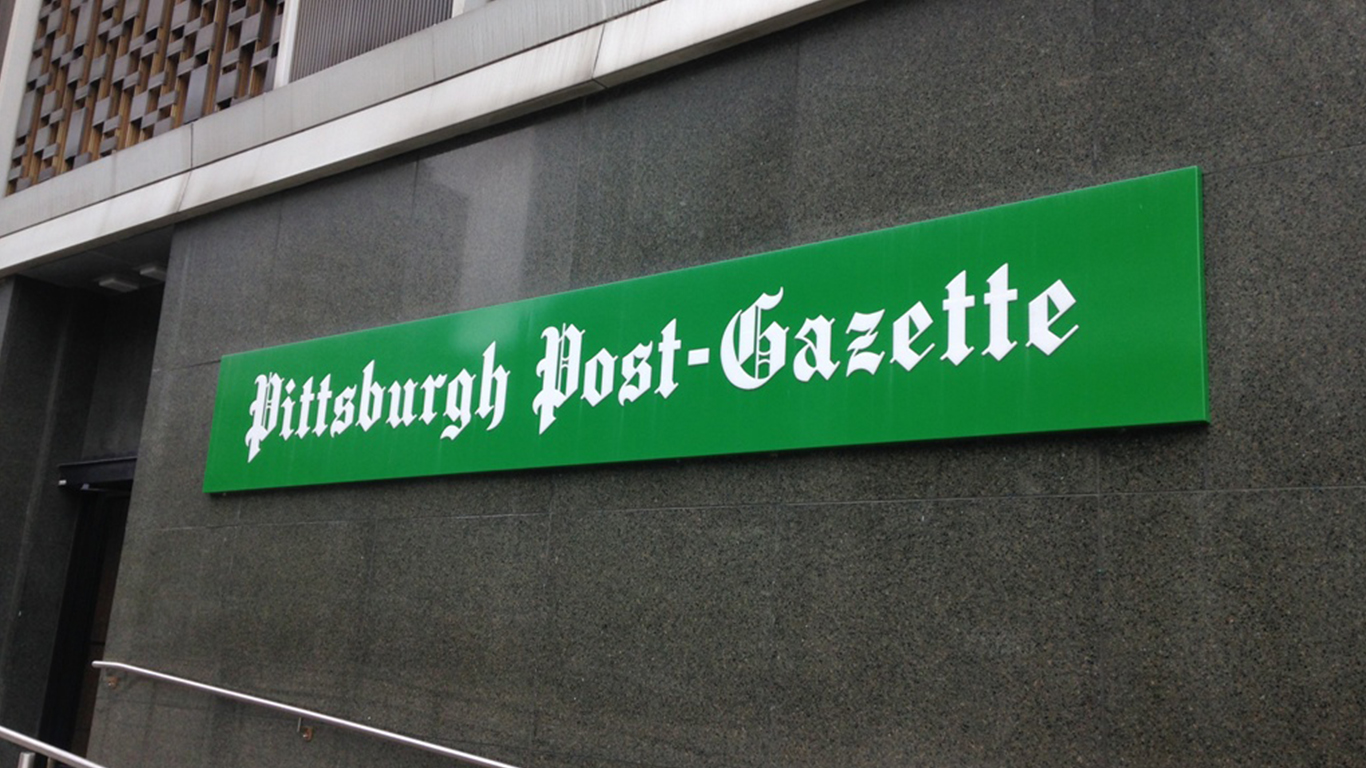
6. Pittsburgh Post-Gazette
> Year founded: 1786
> Place founded: Pittsburgh, PA
> Original name: The Pittsburgh Gazette
In 1786, a Pennsylvania state assemblyman, writer, and lawyer named Hugh Henry Brackenridge brought two 21-year-old Philadelphia printers, John Scull and Joseph Hall, and a wooden printing press to Pittsburgh to start the Pittsburgh Gazette, a weekly that was the first newspaper published west of the Alleghenies.
Hall died a few months after the first issue of the Gazette appeared, but Scull continued to publish it, at first under the close supervision of Brackenridge and then in political opposition to him, until 1816. Several other owners took it over in succession, and in 1820 it was renamed Pittsburgh Gazette, and Manufacturing and Mercantile Advertiser. In 1833, again under the name Pittsburgh Gazette, it was taken over by author, editor, and composter Neville B. Craig, who ran it until 1841, transforming it along the way into Pittsburgh’s first daily.
Craig’s successor, David N. White, was a leading abolitionist, who turned the Gazette into an important anti-slavery publication. A subsequent owner, Nelson P. Reed, who took it over in 1866, combined it with another paper, the Pittsburgh Daily Commercial, which had been founded in 1863, to form the Commercial Gazette.
The paper became just the Gazette again in 1900, later merging with the Pittsburgh Times, to become the Gazette-Times. It passed into the hands of the legendary William Randolph Hearst in 1927. The same year, a German immigrant and experienced newspaperman named Paul Block, Sr., who owned two other local papers, the Post and the Sun, arranged to swap the Sun for Hearst’s Gazette-Times, and Block created the Post-Gazette.
The Block family has owned the Post-Gazette ever since, now through the Toledo, Ohio-based Block Communications, Inc., which also owns the Toledo Blade and other newspapers and broadcast properties. As of earlier this year, the Post-Gazette cut its publishing schedule to five days a week, giving Pittsburgh the dubious honor of being the largest American city without a daily printed paper.

5. Daily Hampshire Gazette
> Year founded: 1786
> Place founded: Northampton, MA
> Original name: The Hampshire Gazette
Founded in Northampton, north of Springfield, in 1786 by 22-year-old William Butler, who had been a printer’s apprentice in Hartford, Connecticut, the Hampshire Gazette may have come into existence as a result of Shays’ Rebellion — a conflict between state government officials and a large group of farmers facing foreclosure for delinquent taxes and non-payment of other debts. Historians believe that Butler was encouraged to start his paper as an organ of government efforts to quell the uprising, and a week after the Gazette’s first issue, it published a proclamation by Massachusetts Gov. James Bowdoin calling for state officials to suppress “all such treasonable proceedings.”
Butler published the Gazette until 1815. For the next century, the paper operated under numerous owners and partnerships. It became the Hampshire Gazette and Northampton Courier in 1858 and continued as a weekly under that name until 1917. Meanwhile, an offshoot, the Daily Hampshire Gazette, appeared in 1890. In 1917, the daily and weekly editions merged.
The paper’s business manager, Harriet Williams DeRose, bought it in 1929, becoming one of the nation’s first female newspaper publishers. Her son and then her grandsons continued to run the paper until 2005, until it was bought by Newspapers of New England, which also owns two other Massachusetts publications, including the Recorder in Greenville (see No. 10).
[in-text-ad]
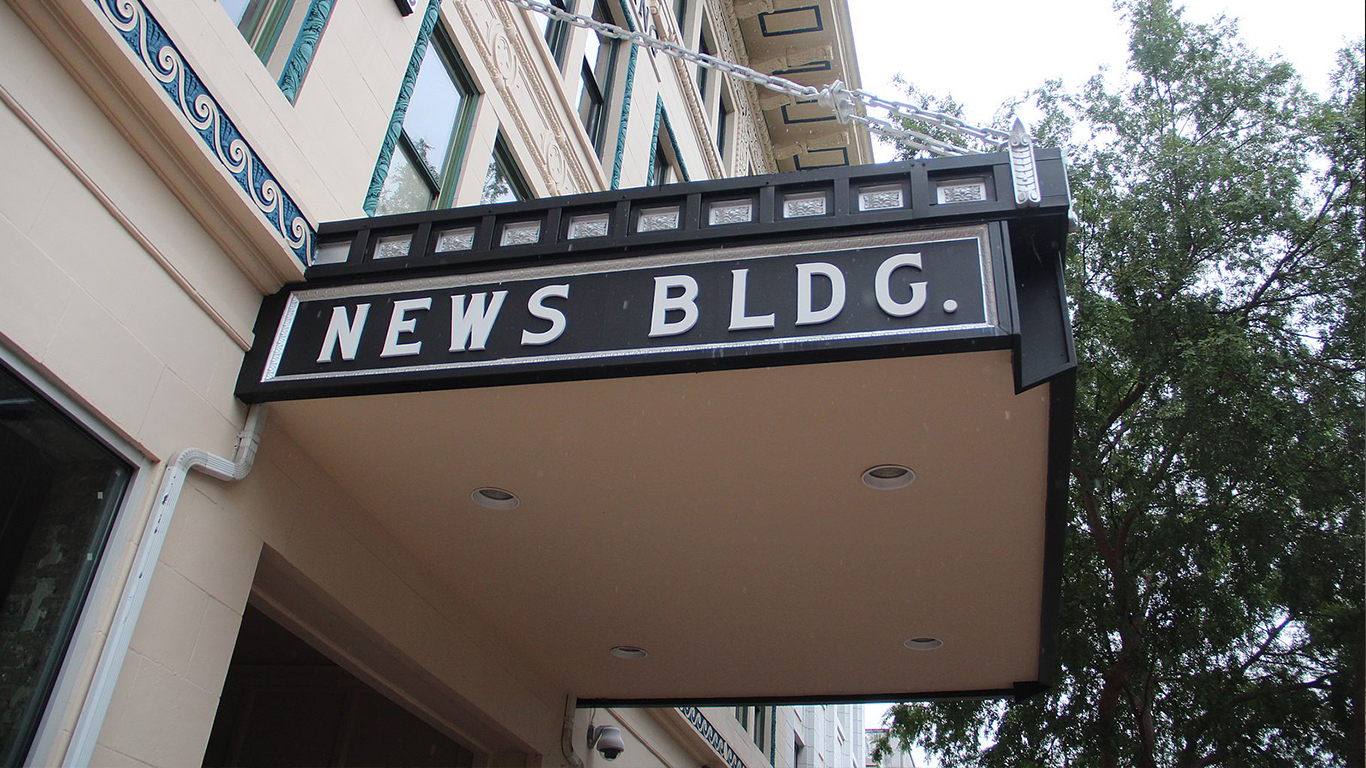
4. The Augusta Chronicle
> Year founded: 1785
> Place founded: Augusta, GA
> Original name: The Augusta Gazette
Printer Greenberg Hughes founded the Augusta Gazette in the Georgia town of Augusta, southeast of Atlanta, in 1785. He decamped the following year, and the paper was taken over by a German immigrant named John Erdman Smith, who renamed it the Augusta Chronicle and Gazette of the State. He remained in charge until 1803, and several other owners and editors took over before 1825, when it came into the hands of A.H. Pemberton, who shortened its name to Augusta Chronicle, and used his editorship to advocate secession and oppose the abolition of slavery.
Pemberton sold the paper in 1835, and the next year it merged with a competitor, the States Rights Sentinel, which had been started by prominent Augusta lawyer, politician, and minister, Augustus Baldwin Longstreet. The Augusta Chronicle and Sentinel, which first appeared in January of 1837, was the city’s first daily.
Under brothers William S. and James W. Jones, who bought the paper in 1840, it remained an advocate of slavery, but a later editor, Nathan Morse of Connecticut, installed after the start of the Civil War, became a critic of Confederate President Jefferson Davis. After the war, Morse sold the paper, and it had a number of editors and publishers through 1929, when it was sold to the International Paper and Power Company. The paper company’s president, William S. Morris, Jr., bought the Chronicle from International Paper in 1945. He later bought another local paper, the rival Augusta Herald, as well as the local radio and TV stations.
Morris’s son, Billy Morris, established Morris Communications Corporation, which acquired other media properties. The company sold the Chronicle to GateHouse Media in 2017 and today the company specializes in city magazines and the “Where” travel guides, among other businesses.

3. The News Journal
> Year founded: 1785
> Place founded: Wilmington, DE
> Original name: The Delaware Gazette
Despite rumors of an earlier, short-lived Delaware newspaper, the state’s first authenticated paper was the Delaware Gazette, started in Wilmington in 1785 by one Jacob Killen. Killen sold it two years later, and it went through a number of owners in the ensuing decades. In 1828, it took over two other Delaware papers, the Patriot and the American Watchman, and became the Delaware Gazette and American Watchman.
In 1858, Caleb P. Johnson, who had worked as a printer in Philadelphia, New York, and Washington, D.C., became editor and publisher of the paper, by then just the Delaware Gazette, holding the position for almost 30 years. In addition to the Gazette, a weekly, Johnson began publishing the Wilmington Daily Gazette, which in 1878 merged with a paper called Every Evening and Commercial (itself formed from two other publications), to become Every Evening, Wilmington Daily Commercial. The weekly Gazette, meanwhile, merged with Every Evening’s weekly version to become the Delaware Gazette and State Journal.
A new daily, the Morning Herald, was founded in 1876 by Philadelphia attorney John O’Byrne. This later became the Daily Morning News. A new afternoon paper, the Evening Journal, appeared in 1888, merging with the daily Every Evening in 1933. Alfred I. du Pont, the famed Delaware industrialist and businessman, owned the Morning News between 1911 and 1920, which he merged it with the Evening Journal to form the News-Journal. The News-Journal Co., under the umbrella of a du Pont holding company, retained ownership until 1978, when it was sold to Gannett Co., its current proprietors.
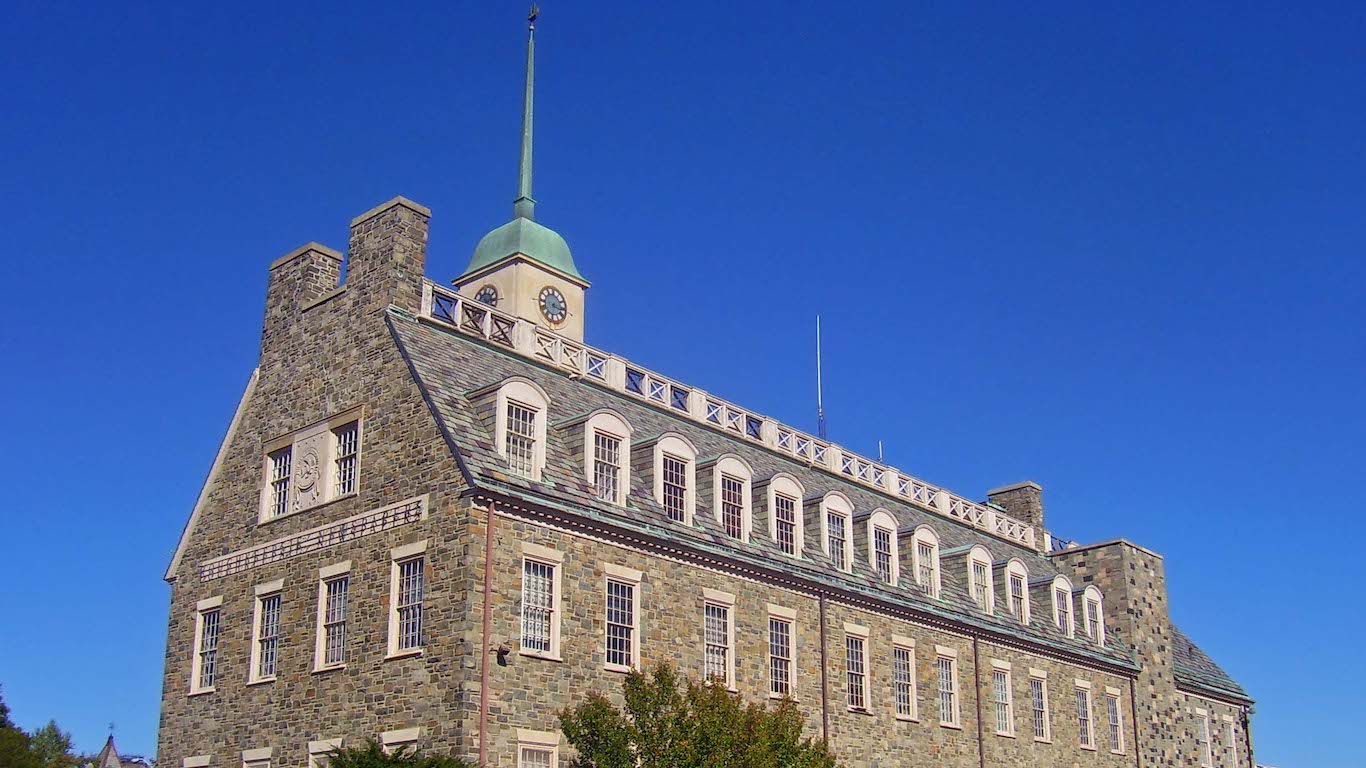
2. Poughkeepsie Journal
> Year founded: 1785
> Place founded: Poughkeepsie, NY
> Original name: The Country Journal, and the Poughkeepsie Advertiser
In the summer of 1785, Nicholas Power, a dry goods merchant in the Hudson River Valley town of Poughkeepsie, started a weekly newspaper called the Country Journal and Poughkeepsie Advertiser. Along with publishing legal notices and accounts of local goings-on, he covered the 1788 New York convention — in Poughkeepsie, then the state capital — at which the state ratified the new U.S. Constitution, and printed a letter to the editor by none other than George Washington.
The paper briefly became The Country Journal, and Dutchess and Ulster County Farmer’s Register, but in 1789, the year Washington became president, Power changed its name to the Poughkeepsie Journal. New names kept coming — the Poughkeepsie Journal and Constitutional Republican, the Poughkeepsie Daily Eagle, the Poughkeepsie New Yorker, and others. In all, since Power’s day, the paper has known 13 name changes and combined with 10 different newspapers. In 1960, though, in honor of its 175th anniversary, it became once again the Poughkeepsie Journal, remaining so except for a temporary name change to Poughkeepsie Journal A.M. Edition between 1980 and 1982. Since 1977, the Journal has been owned by Gannett Co.
[in-text-ad-2]
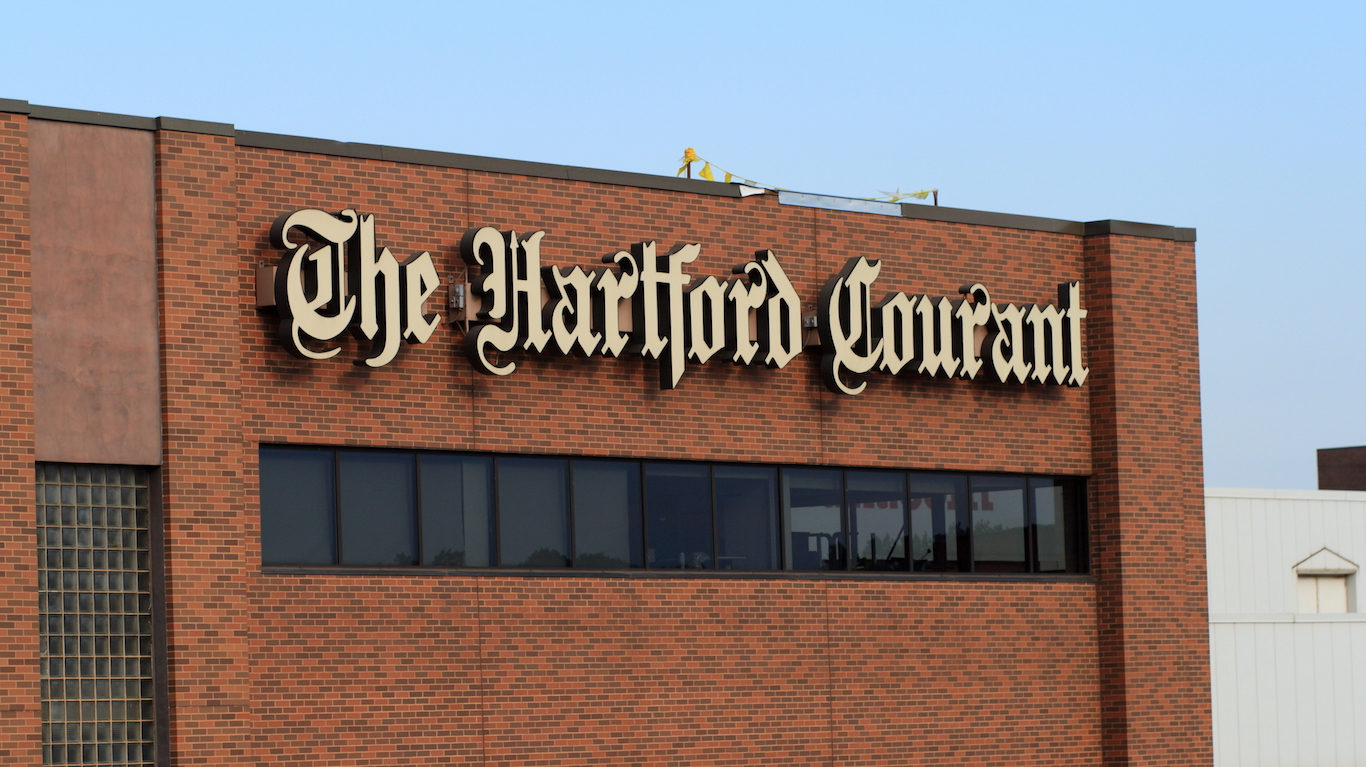
1. Hartford Courant
> Year founded: 1764
> Place founded: Hartford, CT
> Original name: The Connecticut Courant
The oldest newspaper in America got its start because fourth-generation printer Thomas Green got fired by Benjamin Franklin. He had been publishing Connecticut’s first newspaper, the Connecticut Gazette, at a New Haven print shop set up by Franklin. But Franklin wanted to give the enterprise over to his nephew, so he let go of Green and his apprentice, Ebenezer Watson.
Green and Wilson moved to Hartford and rented a space above Mookler’s barbershop. Some sources say that he began printing the paper he dubbed the Connecticut Courant out of a tavern called the Heart and Crown. In fact, that was the name of his print shop, and he fashioned a tavern-style sign to advertise it.
In 1765, Green and Watson hired a young neighborhood boy, George Goodwin, as a “printer’s devil” (apprentice). In 1768, Green moved back to New Haven, where he started a paper of his own, giving the Courant over to Watson. The weekly Courant became a leading proponent of independence from British rule, criticizing the Stamp Act (which imposed taxes on newspapers and official documents), reporting on the Boston Tea Party, and, on July 15, 1776, publishing the Declaration of Independence as breaking news.
Watson died of smallpox in 1777, leaving the paper to his widow, Hannah, a pioneering American female newspaper publisher. She brought in George Goodwin, a week before his 21st birthday, as her partner, and the two ran the paper for the next 36 years. The paper became a daily and was renamed the Hartford Courant in 1837, the year it was sold to a former apprentice at the Courant, John Boswell.
The publication remained under local ownership, though the particulars varied, until 1979, when the Los Angeles-based Times-Mirror Co. bought it. In 2000, the Chicago-based Tribune Co. bought Times-Mirror, including the Courant. The paper is now owned by Tronc, as the Tribune Co. was rechristened in 2016. (The much ridiculed name will soon be changed back to Tribune Publishing.)
Detailed Findings
The oldest English-language newspaper in existence is the News Letter, out of Belfast, Northern Ireland, established as the Belfast News Letter and General Advertiser in 1737. The oldest American paper still published today — the Hartford (Connecticut) Courant — came along in 1764. Until earlier this year, that honor would have been held by the Newport Mercury, established in 1758 by James Franklin, with the help of his celebrated uncle, Benjamin. Earlier this year, however, the Mercury — which had become a free weekly tabloid — ceased publication, and now exists only as a website and a monthly supplement to the Newport Daily News.
The newspaper publishing business in America has been vigorous and highly competitive from the start. The history of every one of these publications is full of rivalries, mergers, and frequent changes of ownership. It’s also worth noting that many newspapers were founded by young men who were printers by trade, and that rather than breaking news, which would have been largely unobtainable in an era before rapid mass communications, they primarily published legal notices, political opinion, and even poetry.
One of the most popular names for early newspapers (which survives in some publications today) was “Gazette” — a word borrowed from French, which might in turn come from “gazet,” an old Venetian coin that might have been the price of an early paper, or from “gazza,” Italian for magpie (in the metaphorical sense of someone who collects little things). “Intelligencer” and “Courier” were also popular names, as were “Democrat” and “Republican,” the latter of which sometimes, counterintuitively, didn’t refer to the Republican Party.
Whatever their history and their name, all these venerable newspapers have interesting stories.
Methodology
To determine which of the nation’s currently extant 8,500 or so daily and non-daily newspapers are the oldest, 24/7 Wall St consulted the Library of Congress U.S. Newspaper Directory; the websites of New York State Historic Newspapers, Timothy Hughes Rare & Early Newspapers, and Newspaper Archives; numerous state and regional historical sites; and Rowell’s American Newspaper Directory (covering the years 1869–1909) and N.W. Ayer & Son’s American Newspaper Annual (1880–1920).
Though some newspapers on this list ceased publication for brief periods, all can trace their lineage directly back to their given founding date. Two newspapers that often appear on “oldest” lists aren’t here because of long gaps in continuity: The Register-Star, published out of Hudson, New York, which descends from the 1785-vintage Hudson Gazette, ceased publication for more than two decades in the early 19th century; and the Cherokee Phoenix, the first American Indian Newspaper, which was first printed in 1828 but was out of business from 1906 to 1975.
Credit card companies are at war, handing out free rewards and benefits to win the best customers. A good cash back card can be worth thousands of dollars a year in free money, not to mention other perks like travel, insurance, and access to fancy lounges. See our top picks for the best credit cards today. You won’t want to miss some of these offers.
Flywheel Publishing has partnered with CardRatings for our coverage of credit card products. Flywheel Publishing and CardRatings may receive a commission from card issuers.
Thank you for reading! Have some feedback for us?
Contact the 24/7 Wall St. editorial team.